




The rapid adoption of clean energy technologies and behav ioral changes in the building sector, supported by innovation strategies, has the potential to significantly lower CO2 emis sions by 2030 and pave the way to achieving the zero-carbon buildings stock targets, according to the IEA's Net Zero Emis sions by 2050 Scenario. Heat pumps combined with energy storage or solar energy provide various options and opportu nities to reach some of the most significant short- and longterm objectives for the building sector. The impact of smart controls and thermal and electric storage to transform heat pumps into a powerful source of flexibility has been inferred in the foreword of this issue.
Under the title "Look to the Nordic countries," the column provides how the Nordic countries Norway, Sweden, Finland, and Denmark experience being the European heat pump powerhouse with the highest heat pump sales per capita.
In the Heat Pumping Technologies news section, you can read a summary of the report from the side event "Innova tion and policy measures to solve the heat challenge". An excerpt from the release of the IEA report “Technology and innovation pathways for zero-carbon-ready buildings by 2030 – A strategic vision from the IEA Technology Collaboration Programmes" and a summary of "The Future of Heat Pumps and a special report in the IEA’s World Energy Outlook" series.
The topical and non-topical articles of this issue provide a platform to explore a strategic focus on Integrated and de centralized energy solutions through (i) the research develop ment of heat pump systems that integrate local production, excess heat/cooling, storage, and consumption and (ii) smart integration of heat pumps into the energy systems.
Enjoy your reading!
Metkel Yebiyo, Editor Heat Pump Centre
The central communication activity of the Technology Collaboration Programme on Heat Pumping Technologies (HPT TCP)
Disclaimer HPC:
All rights reserved. No part of this publication may be reproduced, stored in a retrieval system, or transmitted in any form or by any means, electronic, mechanical, photocopying, recording or otherwise, without prior written permission of the Heat Pump Centre, Borås, Sweden.
Published by Heat Pump Centre c/o RISE - Research Institutes of Sweden, P.O. Box 857, SE-501 15 Borås, Sweden Phone: +46 10 516 53 42
Neither the Heat Pump Centre, nor any person acting on its behalf: makes any warranty or representation
• express or implied, with respect to the accuracy of the information, opinion or statement contained herein
• assumes any responsibility or liability with respect to the use of, or damages resulting from, the use of this information
Foreword: How heat pumps can be part of a clean ener gy package, by Jan Rosenow Column: Look to the Nordic countries, by Rolf Iver Hagemoen Heat Pumping Technologies News Ongoing Annexes in HPT TCP
Smart integration of heat pumps by predictive controls, by Christina Betzold and Arno Dentel
Opening the black-box: A case study of a borehole thermal storage, by Tobias Dokkedal Elmøe Analysis of the use of ground source heat pumps for Brazilian climate and soil conditions, by Alberto Hernandez Neto and Cristina de Hollanda Cavalcanti Tsuha
The beauty of reason and insight: a story about 30 years old borefield equations, by Lucas Verleyen, Wouter Peere, Emma Michiels, Wim Boydens, Lieve Helsen
Austria: Heat Pump Market Report , by Siegfried Thurner Events National Team Contacts
All information produced by Heat Pump Centre falls under the jurisdiction of Swedish law.
Publisher: Heat Pump Centre P.O. Box 857, SE-501 15 Borås Sweden Tel: +46-10-516 53 42 hpc@heatpumpcentre.org
www.heatpumpingtechnologies.org
Front page reference:
Copyright: © Heat Pump Centre (HPC) Editor in chief: Monica Axell Editor: Metkel Yebiyo Technical editors: Metkel Yebiyo, Caroline Haglund Stignor Layout: Anneli Rosenkvist – Heat Pump CentreSimilar to other clean energy technologies, policymakers frequently consider heat pumps in isolation. They design well-meaning policies specifically to support heat pumps, for example, by providing grants to households to encourage in stallation. By the same token, installers of clean energy tech nologies often only offer a single technology – solar installers offer solar panels, heat pump installers offer heat pumps, and building retrofit companies offer insulation. However, it is be coming increasingly clear that integrating several clean ener gy technologies with a heat pump can deliver cost savings to consumers, support the electricity system, and reduce carbon emissions faster.
Recent analysis by the International Energy Agency shows that by combining a heat pump with photovoltaics, the solar array can provide more than 40% of the electricity needed to run the heat pump. Add in a battery and expand the buffer for the heat pump, and the photovoltaics can cover more than half of the heat pump’s electricity consumption. This leads to significant cost savings: German daily newspaper Handelsblatt published calculations by the national consumer association, documenting that, over 20 years, an air-source heat pump with on-site solar is 17% cheaper to install and run than the heat pump alone and more than 40% cheaper than a gas boiler in Germany.
Beyond integrating heat pumps with other clean energy technologies at the building level, there are other important opportunities for strategic use of heat pumps to accommodate a rising share of renewable energy sources. In the past, flexibility in power systems has garnered the most attention, with only limited consideration of heat demand. However, with increasing integration of the power and heat sectors, this heat flexibility becomes highly relevant. Rather than thinking of heat pumps as a burden on the electricity grid, we should see them as part of the solution. Smart controls and thermal and electric storage can turn heat pumps into a powerful source of flexibility. Energy-efficient buildings maintain indoor temperatures for several hours without a notable loss in comfort. Pre-heating and pre-cooling buildings with heat pumps during periods of significant generation from on-site solar or on-grid renewables reduces the need for heat pumps to draw electricity during peak hours when the dirtiest gen erators are operating.
With the opportunities so plentiful, where next? Heat pump policies should promote the in tegration of packages of clean energy technologies instead of just focusing on heat pumps as standalone solutions. Installers can offer customers an integrated package of technologies. Just as solar installers already include battery options in their quotes, it makes a lot of sense for heat pump installers to adopt a similar approach sense. The momentum for heat pumps is growing by the day – let’s make the most of the opportunity!
Jan Rosenow, PhD Director of European Programmes
Director of European Programmes
The Regulatory Assistance Project jrosenow@raponline.org

There are currently two megatrends that will affect the heat pump market in Europe in the coming years. One is the rapid phasing out of fossil energy in heating, which significantly increases the demand for heat pumps. The other is the shift towards natural refrigerants.
Through ambitious targets in the EU's "Fit for 55" and "REPowerEU" packages and similar developments on the national level, the use of fossil fuels will decrease dramatically before 2030. Increased use of heat pumps is highlighted as one of the most important measures for the EU to fulfill these ambitions. The European Heat Pump Association (EHPA) estimates that the targets require an additional 20 million heat pumps by 2026 and nearly 60 million additional heat pumps installed in the EU by 2030.
Analyses from EHPA show a very strong correlation between high sales numbers and a favorable price ra tio between fossil oil or gas and electricity. A value of less than three will make heat pumps more attractive than fossil boilers. The Nordic countries Norway, Sweden and Finland have the highest heat pump sales per capita. In all three countries, electricity has been relatively cheap for many years. At the same time, the CO2-taxes are among the highest in Europe, which has made fossil energy more expensive.
In the neighbouring country Denmark, the heat pump market has historically been low due to high elec tricity taxes and extensive use of gas for heating or district heating based on fossil energy. Heat pumps are now on the rise after the electricity taxes have been reduced, CO2-taxes are increasing, and fossil gas for heating will be phased out by 2030.
Gas is no important competitor for heating in buildings, partly due to the little developed gas infrastruc ture. The infrastructure for electricity has been robust in Norway, Sweden and Finland for decades. This makes heat pumps combined with electric heating very common. With its robust electricity infrastructure, France has long been the biggest market for heat pumps in Europe.
In countries where heat pumps dominate, profitability is the most important driver for customers. Al though heat pumps have a higher investment cost than fossil fuel boilers, they are the most profitable heating source in countries such as Norway, Sweden, and Finland. The price competition with fossil energy must be resolved, or bans for fossil fuels must be introduced if heat pumps are to grow at the pace that is necessary to meet the EU's climate targets. In Norway, fossil fuel was banned in new buildings in 2016, and fossil oil has been banned in all buildings since 2020.
Increasing heat pump sales will increase the demand for refrigerants. At the same time, the availability of refrigerants is limited by the phase-down quota from the EU F-gas regulation. This is currently resulting in a shift towards natural refrigerants in heat pumps. Over the past years, heat pumps using propane and CO2 in residential buildings have been niche products, while naturally occurring refrigerants were flour ishing in district heating and light commercial applications. This is expected to change as most of the big brands are introducing new products to the residential heating market.
The EU Commission has proposed further tightening the hydrofluorocarbons quota system through the F-gas regulation. It is not yet known how strict the new regulations will be, but everything points in the direction of more natural refrigerants such as propane, CO2, and ammonia. In 2023, there may also be a ban on certain HFOs due to increased concentrations of TFA in nature, which researchers believe is linked to the leakage of refrigerants.
Hence it is advisable for heat pump manufacturers to monitor this change carefully and to build up the necessary R&D and production skills to shift refrigerants according to the new regulation.
SecretaryOn November 30, IEA released The Future of Heat Pumps, a special report in the IEA’s World Energy Outlook series. The report provides an outlook for heat pumps, identifying key opportunities to acceler ate their deployment. The report also highlights the major barriers and policy solutions and explores the implications of an accelerated uptake of heat pumps for energy security and efforts to tackle climate change. One of the key messages of the report is that heat pumps are the key solution to reduce natural gas use for heating, support energy security, cut emissions and keep energy bills affordable.
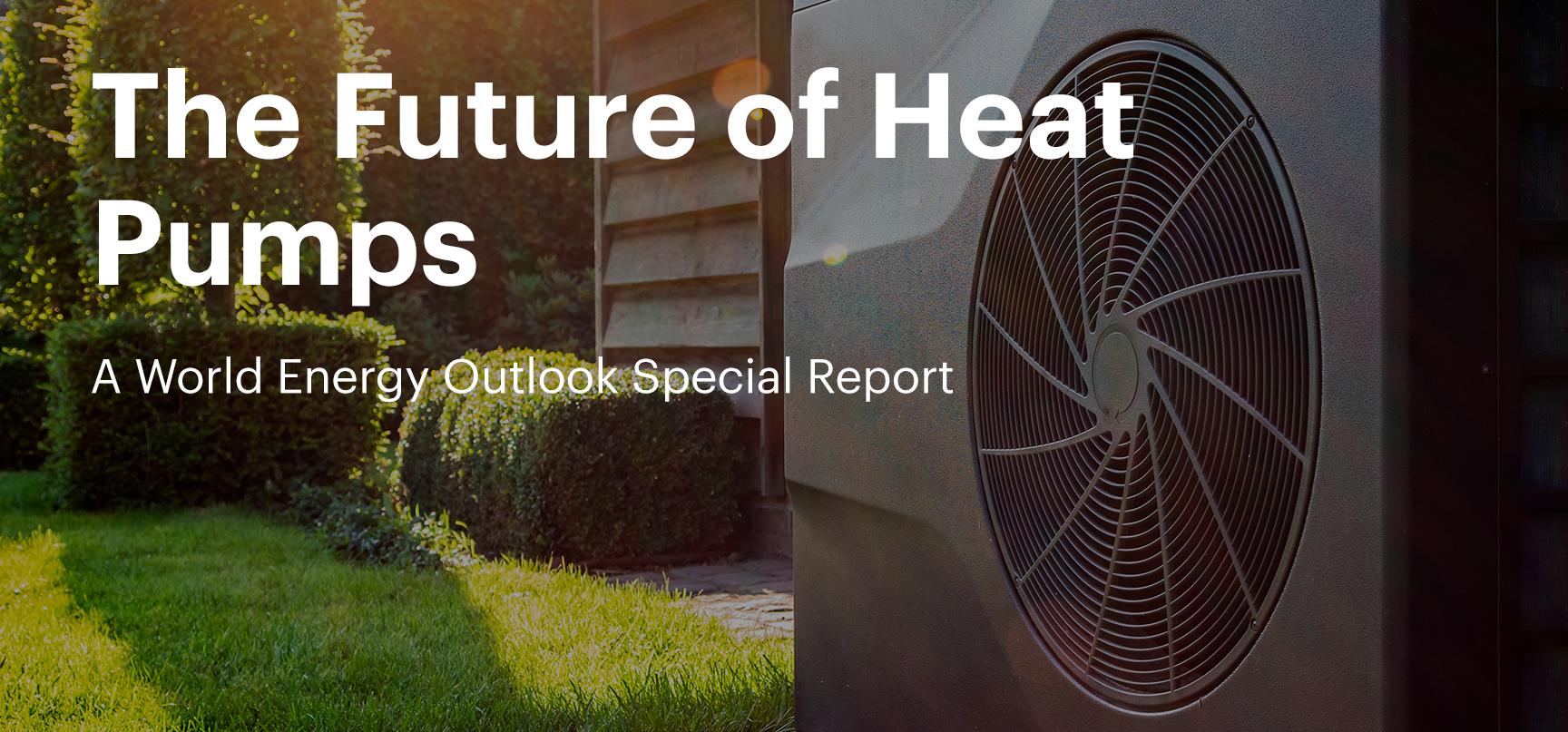
Russia’s moves to sharply reduce natural gas flows into Europe have deepened the global energy crisis. Among the host of measures countries are taking in response to the crisis, heat pumps are one of the most important long-term solutions widely available today to reduce natural gas use for heating, improve energy security, keep consumers’ energy bills affordable, and make progress on reducing emissions. It is stated in the report that heat pumps are receiving unprecedented policy support through the European Union’s REPowerEU Plan, the US Inflation Reduction Act and other policy initia tives around the world. However, key barriers to further scaling up production and deployment of heat pumps remain, such as high upfront purchase prices and oper ational costs, the legacy of the existing building stock, limited manufacturing capacity, and a shortage of workers trained to install the pumps.
According to IEA’s press release Dr Fatih Birol, Executive Director of IEA, has stated that “heat pumps address many of policy makers’ most pressing concerns on energy affordability, supply security and the climate crisis all the pieces are in place for the heat pump market to take off, in a similar way that we have seen for other key climate tech nologies like solar PV and electric vehicles. Policy measures are in place today, but they need to be reinforced urgently to allow heat pumps to fulfil their significant economic and environmental potential.” During the report launch and press conference, he told that heat pumps is such an important clean energy technology today. Therefore, a special report on heat pumps was needed beyond having its own chapter in the World Energy Outlook report.
This report is the first comprehensive global outlook on the subject. It conveys the message that heat pumps are a hyper-efficient and climate-friendly solution, which help consumers save money on bills and enable countries to cut reliance on imported fossil fuels, which is an important message today, when heating of most buildings on a global level still relies of fossil fuels. For many countries in Europe, the fossil fuels have to a large extent, been imported from Russia.
During the launch and press conference, the European Commission Director-General for Energy, Ditte Juul Jørgensen, told that in EU they are right now aligning all policies to facilitate the roll-out of heat pumps, for example the EPBD, the EED and Ecodesign regulations. One example is the phasing out of stand-alone fossil
IEA’s special report The Future of Heat Pumps states that the global energy crisis is driving a surge in heat pumps, bringing energy security and climate benefits
boilers by 2029. Heat pumps has also a central role in the REPowerEU policy package. However, even more needs to be done to support the heat pump sector and overcome barriers and therefore this report is extremely valuable.
Around 10% of space heating needs globally were met by heat pumps in 2021, but the pace of installation is growing rapidly, with sales at record levels. The heat pump market has been growing strongly in recent years, and global heat pump sales rose by nearly 15% in 2021, led by the European Union, where they rose by around 35%. According to the report, the heat pump sales are set to soar in the coming years when the energy crisis accelerates their adoption.
Heat pumps typically cost less over their lifetimes than fossil fuel boilers, thanks to their higher efficiency. At today’s energy prices, the analyses performed by IEA show that annual energy bill savings for households that switch to heat pumps can range from USD 300 in the United States to USD 900 in Europe. However, govern ment policy support is needed to help consumers overcome heat pumps’ higher upfront costs relative to alternatives in many countries.
Since the technology is well proven, even in the coldest of climates and offers several benefits, IEA advises policy makers to put their weight behind this technology that is witnessing unprecedented momentum at the moment.
In a scenario in which all governments achieve their energy and climate pledges in full, heat pumps become the main way of decarbonising space and water heating worldwide. The IEA estimates heat pumps have the potential to reduce global carbon dioxide (CO2) emissions by at least 500 million tonnes in 2030 – equal to the annual CO2 emissions of all cars in Europe today.
Leading manufacturers are seeing promising signs today and believe that sales could be tripled by 2030. Already today, there are announced plans to invest more than USD 4 billion in expanding heat pump production and related efforts, mostly in Europe.
During IEA’s launch of the report and press conference on November 30, Gerteric Lindquist, the CEO of NIBE, represented the heat pump industry and commented the report. He said it was almost overwhelming to hear the technology being so well acknowledged. He has been working within the heat pump industry for more than 35 years and has been waiting for this to happen. He confirmed that industry is going to take on this challenge very seriously, when they have this great support from IEA as well as from policy makers in different parts of the world. However, further policy support is still needed in some countries, e.g. there is still a need for pricing and taxation that favours heat pumps.
The rapid expansion of heat pumps presents some challenges, but the report highlights solutions to these barriers. Heat pumps will inevitably increase electricity demand. However, energy efficiency can greatly reduce the impacts on the grid, alongside with improved grid planning. Global heat pump supply and installation could require over 1.3 million workers by 2030, nearly triple the current amount, raising the potential for skilled labour shortages, especially for installers. Special training programmes are therefore needed.
Opportunities also exist for heat pumps to provide low-temperature heat in industrial sectors, especially in the paper, food and chemicals industries. In Europe alone, 15 gigawatts of heat pumps could be installed across 3 000 facilities in these three sectors, which have been hit hard by recent rises in natural gas prices, according to the report.
Three different scenarios are compared in the report; each scenario is based on a different vision of how policy makers might respond to today’s crisis. In the Stated Policies Scenario (STEPS), they explore how the energy system evolves if we retain current policy settings. In the Announced Pledges Scenario (APS), governments' climatic targets are achieved on time and in full. Only in the Net Zero Emissions by 2050 (NZE) Scenario, IEA works back from specific goals – the main one, in this case, being to cap global warming to 1.5°C – and show how they can be achieved.
The graphs below show how the heating capacity of heat pumps, and the share of heating needs they will cover, are expected to develop in the different scenarios. Around 20% of heating needs will be met by heat pumps in 2030, according to the Announced Pledges Scenario (APS), with China, North America and Europe remain ing the leading markets; see Figure 1.7 from the report. However, there is still a gap in the Net Zero Emissions by 2050 (NZE) Scenario in which the capacity and share need to increase, even more; see Figure 1.12 from the report.
The network of HPT TCP has contributed with data, facts and review to this report for many different aspects. The long and consistent work within this collaboration programme has clearly contributed to the development of the technology, resulting in that it is now a mature, tested and proven technology which keeps millions of homes warm already today. However, to transform and decarbonize the energy system and to be able to reach the climate ambitions, further research, development and demonstrations are needed. HPT TCP provided input to describe these needs in the report, which can be found in Box 1.1 in the report and summarized as follows.
» smart and flexible features, interacting with the grid and other clean energy technologies
» higher efficiencies over a larger temperature range (very cold climates, higher heating temperatures)
» more compact design, improved ease of installation
» lower environmental footprints and ensured safety associated with the materials and refrigerants used
» adapting heat pumps for the most difficult conditions for carrying out building retrofits
» resource efficiency by optimising the use of heat pumps for both heating and cooling purposes, including in commercial and industrial applications with simultaneous needs or using waste heat from air conditioning to fulfil heating needs
» heat pumps operated in a very low-temperature thermal grid on a district or city level to be used as a heat sink and source simultaneously
» reduced noise
» non-traditional compression technologies for heat pumps such as solid-state (e.g. magnetocaloric, thermoelectric and elastocaloric) and gaseous (e.g. Brayton and Stirling cycles).
Read the full report: https://www.iea.org/reports/ the-future-of-heat-pumps
Read the press release: https://www.iea.org/news/ the-global-energy-crisis-is-driving-a-surge-in-heat-pumpsbringing-energy-security-and-climate-benefits
Figure 1.7. (in the report) Heat pump capacity in buildings by country/region and scenario, 2021 and 2030. Source: IEA Special Report The Future of Heat Pumps
Figure 1.12. (in the report) Global heat pump capacity and coverage of heating needs in the APS and NZE Scenario, 2021 - 2050. Source: IEA Special Report The Future of Heat Pumps

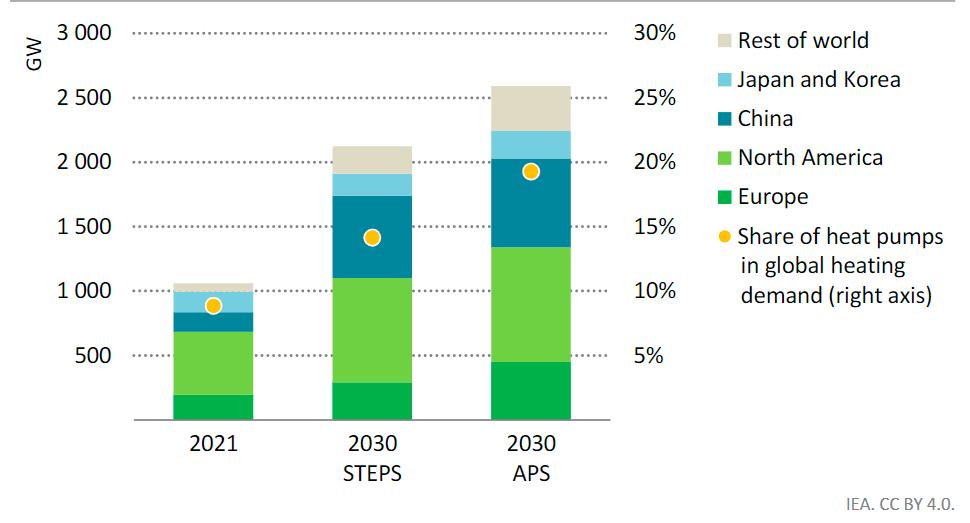
In September a side event for inspiration and learn ing from each other was organized at the Global Clean Energy Action Forum, a joint convening of the 13th Clean Energy Ministerial and 7th Mission Innova tion ministerial meeting, (CEM13MI7) in Pittsburgh.

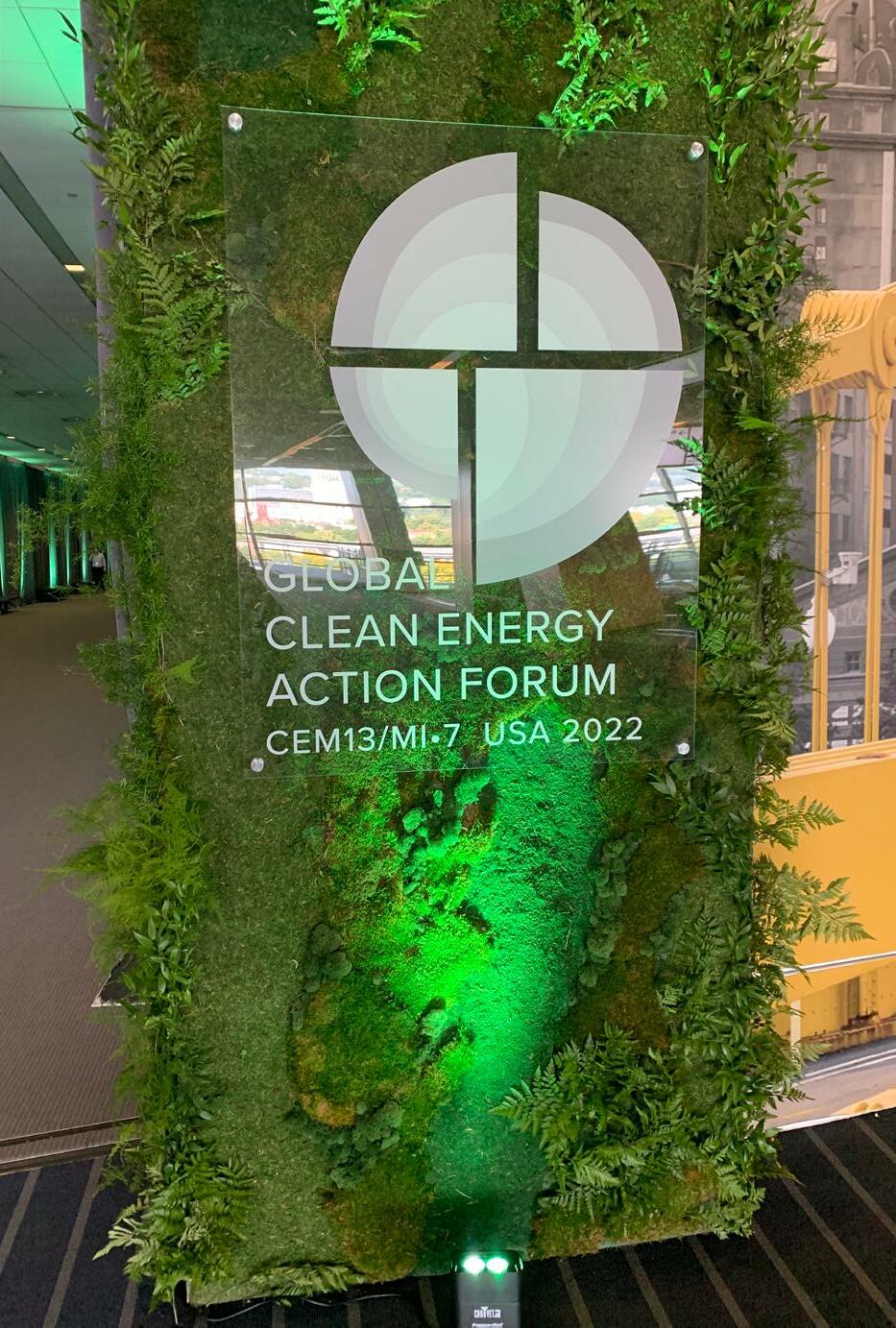
This session presented innovative technology and policy solutions that aim to reduce emissions from the heating sector worldwide. The audience could learn how technologies like the breakthrough Comfort and Climate Box (CCB) can meet heating and cooling needs and be deployed at scale, and how national and subna tional governments are developing technology, financial, and energy policies supporting the rapid deployment of clean heating. The IEA’s Technology Collaboration Pro gramme on Heat Pumping Technologies (HPT TCP) Glob al Alliance for Building and Construction’s (ABC’s) Clean Heat Forum, and Mission Innovation’s Innovation Com munity on Affordable Heating and Cooling of Buildings (MI#IC7) hosted the session.
The side event was opened by a short introduction by representatives from the hosting organizations, Monica Axell (IEA HPT TCP), Piero de Bonis (MI#IC7) and David Smedick (The Global ABC’s Clean Heat Forum). There after a number of presentations and a panel discussion followed.
Transformation in the heating sector needed to reach the climate ambitions Thereafter, Araceli Fernandez, Head of Technology and Innovation, Energy Technology Policy Division within the International Energy Agency (IEA) gave a presentation about the Transformation in the heating sector needed to reach the climate ambitions. To align with the IEA’s Net Zero Emissions by 2050 Scenario substantial energy ef ficiency renovations need to be done within the building sector, and a drastic shift away from fossil fuels-based heating towards electricity and renewables.
See presentation here >
Heat pumps are increasingly recognized as a critical tech nology for heat decarbonization, receiving increasing policy support in several countries over the last years. About 190 million heat pump units were in operation in buildings worldwide in 2021. The global stock of heat pumps has increased quite steadily over the past few years, particularly in primary heating markets – North America, Europe and northern and eastern Asia. In 2021, record high growth in heat pumps sales was registered in particular in Europe, China and the United States; 2022 is also showing early signs of positive growth despite chal lenges in supply chains. Other than climate objectives, energy security is an important driver for heat pumps in the European Union in particular, with increasing policy
attention in 2022. Part of the deployment is also driven by a growing space cooling demand met with reversible heat pumps. Heat pumps still meet only around 10% of the global heating need in buildings though, below the deployment level required to get on track with the Net Zero Emissions by 2050 Scenario. In this scenario, the global heat pump stock reaches about 600 million by 2030, covering at least 20% of global heating needs. Fur ther policy support and technical innovation are needed, in particular to reduce upfront purchase and installation costs, remove market barriers to complex renovations, improve energy performance and durability, and exploit the potential of heat pumps as an enabler of power sys tem integration and flexibility.
The IEA is tracking heat pump technology developments as part of its ETP Clean Technology Guide that includes over 500 technologies and for which the latest edition was released on 22 September. Heat pumps were also a strategic area discussed in the recent report on Tech nology and innovation pathways for zero-carbon-ready buildings by 2030, which provides the strategic vi sion of experts from the IEA Technology Collaboration Programmes on how to help achieve some of the most impactful short-term milestones for the buildings sector outlined in the IEA’s Net Zero by 2050 Roadmap.

Martin Forsén, President of European Heat Pump As sociation (EHPA) talked about the Role out of heat pumps in Europe – policy enablers and barriers. He talked about how the overarching policy framework in Europe, aiming for increased renewable energy, increased energy effi ciency and reduced emission of greenhouse gases has evolved during the last decade with more and more am bitious targets, especially for the share of renewable en ergy. This has resulted in policies supporting increased deployment of heat pumps and the market has respond ed with a substantial growth. Last year the European market increased by 35%. However, to be able to reach the targets in the Fit-for-55 and the REPowerEU package, the yearly sales rate needs to double. For this to happen a comprehensive policy support is needed. Key barriers to further scaling up production and deployment of heat pumps continue to exist such as high upfront purchase prices and operational costs, the legacy of the existing building stock, limited manufacturing capacity and a shortage of workers trained to install heat pumps. It is of uttermost importance to adjust taxes, fees and subsi dies to make clean heating the most affordable solution for end users. Moreover, support is needed to take new innovations to the market, especially when it comes to solutions that could interact with and support the elec tric grid. See presentation here >
Thereafter, Ramachandran Narayanamurthy, Manager of the Emerging Technologies Progaramme, US Depart
ment of Energy (DOE), gave a presentation about Role out of heat pumps in the US – policy enablers and barri ers, where he talked about the present actions taken in US to decarbonize heating. To achieve the clean energy generation targets and the economy wide emission re duction goals equitably and affordably several measures are taken. He told the audience about the recently ad opted Inflation Reduction Act (IRA) and Defence Produc tion Act (DPA) which will strongly support clean energy technologies for heating, amongst them heat pumps. Energy Efficiency renovations reduces customer and grid cost. Elimination of onsite emissions is necessary for de carbonizing the building stock. Moreover, demand side flexibility is critical to achieving a carbon free electric grid which operates 24 hours per day, seven days a week. He informed about the “Energy, Emissions and Equity (E3) initiative”, which is focused on developing, demonstrat ing and deploying heat pumps at scale. This includes measures to support the development, improvement and roll-out of cold climate heat pumps, low GWP refrig erants, heat pump water heaters and heat pump diag nostic tools. In addition, it includes better climate pilots and workforce training. He also talked about some prod ucts which could potentially reduce the cost of electri fication of heating, since they will help in reducing the demand for electric infrastructure upgrades. Example technologies within this portfolio is high efficiency (120 V) heat pumps, low power (120 V) heat pump water heat ers with storage and smart panels for demand control. See presentation here >
The next speaker was David Smedick, from RMI repre senting The Global Alliance for Building and Construc tion’s Clean Heat Forum, which was launched at the COP26 meeting last year. The objectives of the Clean Heat Forum are to shape and exchange best practices, co-creation of standards and regulations and by mak ing the case of action by other parties to accelerate heat
decarbonization. He talked about the aim of the initiative which is to connect governments, civil society, industry, and other partners, engaged in the field of clean heating, for them to learn from each other’s best practice and am bitions. See presentation here >

In the final presentation of the event Caroline Haglund Stignor from RISE, representing the Technology Collab oration Programme on Heat Pumping Technologies by IEA (HPT TCP by IEA) presented the “Comfort and Climate Box” project, with focus on a roadmap for scaling and replication och this type of products. She started her in tervention by talking about the different needs to be ful filled to solve the heat challenge. The end user wants to have a comfortable home, to get access to hot water, rea sonable energy bills and a compact plug-and-play solu tion. Some end users have high environmental aware ness. For them, it is of importance with a clean heating solution. Policymakers want to reach their climatic tar gets and to ensure security of supply. It is also of high im portance with reasonable energy bills for the population. When it comes to utilities and grid owners, it is import ant to get an acceptable return on investments. Many of them have emission targets that shall be reached, they need flexibility providers to ensure the security of supply for their clients and to optimize investments. However, which of the needs that is of most importance differ from market to market. In some countries needs related to af fordability is of most importance, on others flexibility, compactness or efficiency has a higher relevance.
One solution to fulfil all these needs is the so called Com fort and Climate Box, which in this context means an
integrated combination of heat pump, energy storage and control – in a box. It could be a real one or a virtual one. In a joint international collaboration project per formed within the heat pumping technologies and en ergy storage TCP together with Mission innovation, the possibilities to develop and accelerate the deployment of this type of solutions have been explored. In one of the prototype developed within this project, different control algorithms were developed and evaluated, which optimized the cost and/or the self-consumption of onsite produced electricity. During the presentation she showed a graph illustrating that the control function pri oritized to operate the heat pump, when the electricity price is low and when the sun is shining on the PV pan els. See presentation here >. The demand for this type of product is growing on markets where the electricity price has a high volatility and many manufacturers are working on their development. Sometimes together with academia.
During this collaboration project recommendations for different stakeholders such as policy makers, utilities and manufacturers where developed, since measures from all these are needed to stimulate the deployment of Comfort and Climate Boxes. First of all, policy makers need to promote and prioritize heat pumps and energy storage in policies – a comprehensive approach is needed. They should also promote clean heating solu tions that can interact with and stabilize the grid. Util ities and grid operators need to inform the end users how they can influence their energy bill by investing in a solution that can interact with the grid, solar panels or their electric car. What manufacturers need to focus on, depends on what is of most importance on the specific market in mind – if it is affordability, flexibility, compact
ness or efficiency. A summary of all the recommenda tions can be found in the presentation here >. For all these measures to be implemented continued research and innovation activities are needed.
The final reports from this project can be found here >.
During the panel discussion, moderated by Jon Salt marsh from Mission Innovation IC7, both Araceli P Fer nandez from IEA and Caroline Haglund Stignor from HPT TCP by IEA talked about the research and innovations needs for accelerated deployment of heat pumping technologies. They both mentioned system integration to connect heat pumps to other clean energy solutions, flexibility and demand side management to interact with and stabilize the electric grid, improved efficiency of heat pumps in an extended operating range, from cold climate heat pumps to heat pumps that operate in high temperature heating systems in buildings, thermal grids and industries, and to explore alternative business mod els to improve the affordability of clean heating solu tions. Caroline Haglund Stignor informed that the HPT TCP has recently revised their strategic work plan, which in addition to the R&I areas mentioned above, includes activities to ensure a sustainable and affordable value chain, improving affordability, and to develop solutions for a circular economy. Within the HPT TCP, research will also continue to be done to develop efficient and safe systems for refrigerants with low global warming poten tial and to explore on non-vapour compression technol ogies, even though they are still on a low TRL level.
Martin Forsén, from EHPA, got the question which is the most important policy measure to accelerate the deploy ment of clean heating that he was aware of, which would be recommended to policy makers in different countries around the world. He answered without doubt: “policies that make the polluter pay, that make clean heating the most affordable solution for end consumer”.
During the end of the panel discussion David Smedick from Clean Heat Forum emphasised the urgency of ac tions to be taken. In only a couple of years we need to halve our emissions and then continue to reduce them to net zero in the next two forthcoming decades. We need to act now!
Monica Axell from RISE, representing HPT TCP by IEA summarized the session. We can conclude from this ses sion that we need a package of long-term commitment from policy, supporting the transition in the heating sector. We also need larger investment in research to bring new innovations to the market, to support scaling and capacity building. The future is collaboration, cross disciplinary approach, and smart system integration of affordable solutions. She also concluded that the future for heat pumps have never been brighter than now. We need to go together and collaborate to inspire to innova tions and solutions to accelerate transition in the heat ing sector.
Piero de Bonis from EC, representing the Mission Innovation #IC7, highlighted the importance to raise the awareness of the urgent need of transition in the heat ing sector to clean solutions.
The United States Department of Energy has named 2022 the Year of Implementation because it is a pivot al year for the fast action required to deliver on glob al climate and clean energy ambition. The first ever Global Clean Energy Action Forum, was a joint conven ing of the 13th Clean Energy Ministerial and 7th Mission Innovation ministerial took place on September 21-22 in Pittsburgh, US, and seeked to deliver on that mission through high-level plenaries, topical roundtables, side events, technology demonstrations, and other activities. The discussions included partners in the private sector, academia, innovators, civil society, youth and communi ties everywhere.
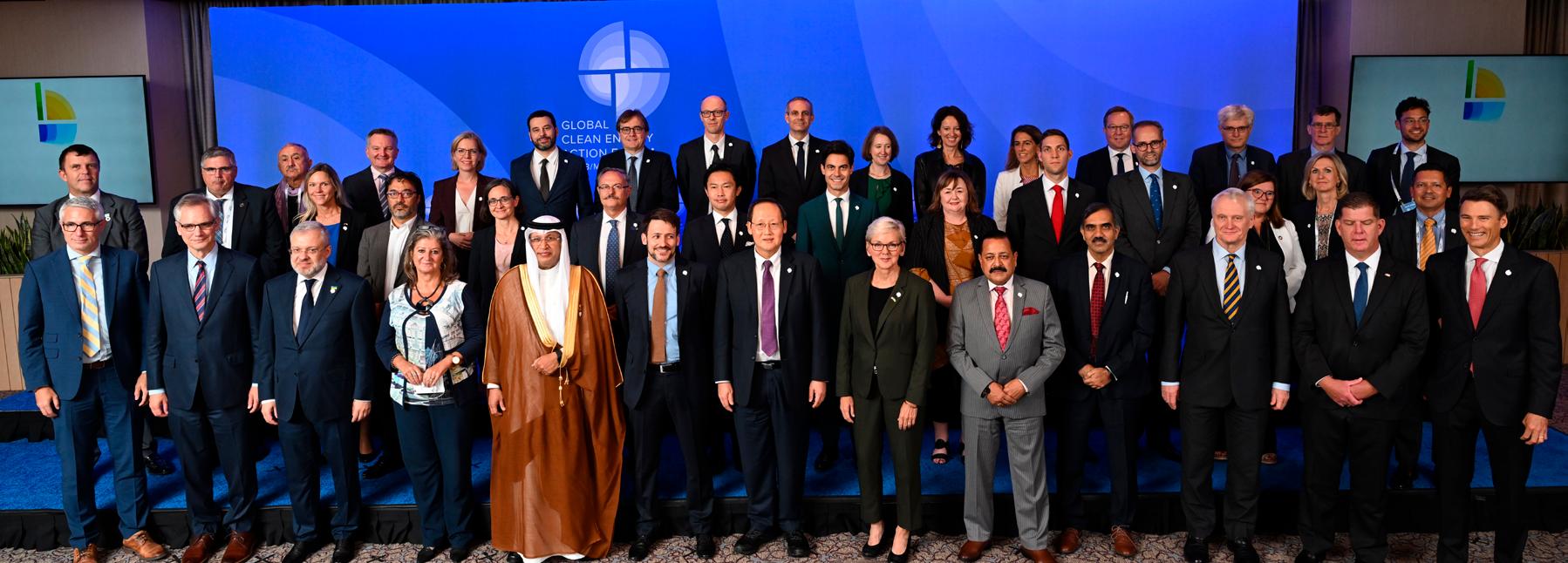

Since October 10, 2022 Czech Republic is a new member in the Technology Collaboration Programme on Heat Pumping Technologies (HPT TCP) under the auspices of IEA, the International Energy Agency. Thereby, the HPT TCP has 18 member countries – two from America, three from Asia and 13 from Europe. Czech Republic is the first country from Eastern Europe to join the HPT TCP.

Czech Republic is a country in the middle of Europe with 10.7 million inhabitants. The major local source of energy is coal, which is used both for electricity (42%) and for heat generation (58%). Gas has also been used in the energy system, for heating as well as for electricity generation and historically 100% has been imported from Russia. Moreover, 40% of the electricity is produced by nuclear power, with plans for extension, and 13% of the electricity is produced by renewables.
The country has ambitions to decarbonize the energy system and in parallel improve the energy security by improving energy efficiency, introducing energy taxations and by improving energy security through import LNG, produce biogas and installations of heat pumps.
A large share of the buildings in Czech Republic are heated by district heating where coal is the main fuel. The govern ment are developing long-term plans for the decarbon ization of district heating systems, for instance by promoting large-scale heat pumps.
The market for distributed heat pumps has grown during the last year and during 2021 22 000 heat pumps were installed.
Czech Republic’s goals for the membership in HPT TCP is to learn, to be able to educate and to contribute to the collaboration. To start with their primary interest is the collaboration project related to heat pumps in district
heating and cooling systems – Annex 57 Flexibility by implementation of heat pumps in multi-vector energy systems and thermal networks.
The Government of the Czech Republic has designated SEVEn, the Energy Efficiency Centre, z.ú. to be the Contracting Party in the HPT TCP, for and on behalf of the Government of the Czech Republic The Executive Committees' representative (delegate) and alternate representative (alternate delegate) will be Tomáš Caha, Senior Technical Expert at Exergie.CZ and Tomáš Voříšek, Technical Director at SEVEn. They both participated, as official delegates for the first time, in the HPT TCP Executive Committee meeting which took place in London, UK on November 9-10.
Contact info to the Czech delegates:
Tomáš Caha tc@exergie.cz
Tomáš Voříšek tomas.vorisek@svn.cz
The HPT TCP ExCo delegate from the UK, Oliver Sutton from BEIS, organized a hybrid onsite and online seminar on November 8 in conjunction with the IEA's HPT TCP Executive Committee meeting, which took place in London the same week. The seminar was opened by Oliver Sutton and the chairman of the HPT TCP, Stephan Renz, who introduced the Technology Collaboration Programme on Heat Pumping Technologies by IEA (HPT TCP) and welcomed the attendees to the workshop. The purpose of the seminar was to exchange information about some exciting research and demonstration projects going on in the UK, policy measures taken to decarbonize the heating sector in the country, and to present some of the work already in progress through IEA HPT TCP projects. In addi tion, Stephan Renz gave an overview of the strategic work plan for HPT TCP (link to full presentation).
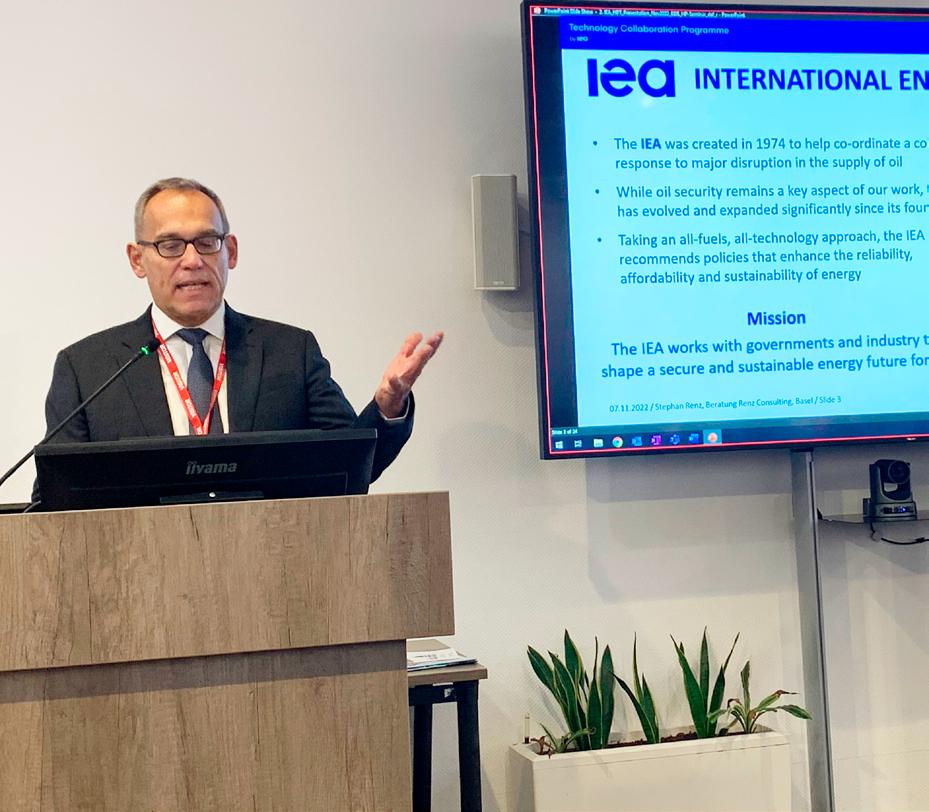
Tara Deshpande, Deputy Director for Clean Heat Policy at BEIS, delivered the next presentation and summarised the UK government policy on heat pumps. Heating is a priority for energy security since it accounts for more than a third of UK emissions, uses half of the country's natural gas supply, and helps the country move away from uncertain international gas markets. Given the variety of buildings and consumer preferences, Tara discussed the important role of heat pumps in decarbonizing. However, to meet the challenge, a variety of heating technologies will likely be needed, including solar thermal, biomass, direct elec tric heating, heat networks, hydrogen for heat, and heat pumps. She discussed the heat and building strategy, which will provide £3.9bn in funding to decarbonize build ings, including £450m for the boiler upgrade program (including subsidies for heat pumps), £950m for the home upgrade grant, £800m for social housing, and £1.4bn for the decarbonization of the public sector.
IEA (HPT
The UK Government has set a goal of deploying 600,000 heat pumps by 2028. To achieve this, the UK policy pack age has highlighted affordability, installer skills, and the electricity system as the three most crucial enablers of heat pump deployment. For example, in addition to the grant, the VAT has been reduced to 0% for energy-saving materials and technologies, including heat pumps. More over, since smart and secure electricity systems are vital enablers, BEIS is consulting on a smart mandate. Finally, they have launched a £60 million Heat Pump Ready Inno vation Programme to foster additional innovation, lower the cost, and enhance the performance of heat pumps (link to full presentation).

As a key solution for decarbonizing homes, heat pumps will be critical for meeting the UK’s legally binding commitment to achieve net zero by 2050 – Report from the BEIS/IEA Heat Pump Research SeminarFigure 1. Stephan Renz, who introduced the Technology Collaboration Programme on Heat Pumping Technologies by TCP) and welcomed the attendees to the workshop.
In his presentation, Martin Forsén of NIBE gave an outline of the upcoming EU regulations, policies, and wider challenges. He demonstrated how the overarching EU-2030 targets that were set in 2018 had been revised. For instance, the GHG-Emission reduction has been revised from 40% to 55% with the goal of net zero by 2050 and negative beyond 2050. This includes the EU-Emission Trading System (ETS) and F-gas regulation. The Energy Efficiency has been increased from 32.5% to 36%, which now incorporates the Energy Performance of Buildings Directives (EPBD), Energy Labeling Regulation, and Energy Efficiency Directives. Additionally, the Renewable Energy Directives III targets have been updated from 32.5% to 45%, with the EU level targets being binding and the MS level targets being non-binding.

Martin also spoke about the EU's high ambitions of decarbonization and energy efficiency and the greater recognition of heat pumps from policy makers in order to double the current deployment rate of individual heat pumps. He stated that when it comes to the recognition from policymakers, we have passed the tipping point; however, in some markets, we still have a way to go to convince the end consumers. He concluded his presen tation by highlighting the major challenges ahead, includ ing Refrigerants, Ecodesign requirements and upcoming requirements related to a circular economy (link to full presentation).
The Heat Pump Deployment Challenge was discussed by Lucy Yu of the Centre for Net Zero, who gave a presenta tion on the open-source agent-based model used to simu late the interventions or combinations of interventions needed to achieve the UK Government's goal of deploy ing 600,000 heat pumps by 2028. They have modeled key government and industry interventions, such as (i) the Boiler Upgrade Scheme £5-6k grant for heat pumps, capped at £450m from April 2022-25, and (ii) Redistribu tion of policy costs across gas and electricity and (iii) Fossil fuel boiler ban commencing on January 2035. For each scenario, they assessed the likelihood that the govern ment's 2028 installation target would be achieved. Accord ing to the results of their research, upfront costs present the largest barrier to adoption by household agents. Even in their most ambitious projections, the upfront cost of a heat pump is still 1.5- 2 times more expensive than an equivalent boiler in the short and medium term. Early ban announcements, consumer awareness raising, and installer training together are key to reaching government targets and beyond (link to full presentation).
Bean Beanland, Director for Growth & External Affairs at the Heat Pump Federation, presented an overview of the UK heat pump industry, challenges and opportunities. His talk focused on how the UK government's long-term poli cy can encourage the industry to train and diversify the workforce, collaborate with the government to educate consumers, invest in supply chain development and bring the best experiences in heat networks into the UK. He said their organization works to raise awareness, understand
Figure 2. Martin Forsén, NIBE talked about upcoming EU regulations, policies, and wider challenges.
ing and confidence in heat pump technology across both domestic and commercial sectors and collaborates with government, industry and consumers to make this a real ity (link to full presentation).
Dave Pearson of Star Refrigeration gave highlights from several examples of large-scale heat pump projects in the UK. He said large heat pump installations could change the way heat is generated in the UK and help decarbon ize existing buildings in cities. He spoke about one £25m upgrade of the district heating system in Drammen, Norway. This innovative project uses a water source heat pump to take low-grade heat from the adjacent fjord and turn it into high-grade heat to supply heating for the 60,000-strong community. Dave emphasized as well as air quality; the key driver was to move from biomass and gas.
Similarly, Kenneth Hoffman of GEA Energy presented projects using high-temperature heat pumps producing heat from 80 to 150 °C, including steam generation for industries. He discussed the variety of industrial ammo nia heat pump installations by GEA in several nations of Europe, including Denmark, Norway, Sweden, and the UK. He mentioned examples of GEA Heat Pumps used in UK Heat Networks, including the Islington Council Bunhill 2 Heat Network, the Gateshead District Heating Network, and the Swaffham Prior Heat Network (link to full presen tation).
Oliver Sutton of BEIS provided an overview of the prog ress of a new UK heat pump project as part of the IEA HPT Annex 60: Retrofitting Heat Pump Systems in Large Non-domestic Buildings. This Annex focuses on “medi um” and “shallow” levels of renovation, where the choice between heat pump systems can be more complex. While complete system replacement is a possible option in these situations, constraints of cost and time will often favor solutions where at least some of the existing system is reused (link to full presentation).
Dan Roberts of Kensa provided highlights from some innovative ground-source heat pump installations in the
UK. He spoke about several cases where large heat pumps have been installed, including in social housing, one flexi ble installation with PCM heat storage (link to full presen tation).

Noel Salmon from the Innovation team in BEIS gave results from BEIS innovation projects, including the Elec trification of Heat demonstration project. The £14.6 million Electrification of Heat Demonstration Project aims to demonstrate the feasibility of a large-scale roll-out of heat pumps in Great Britain. The project was funded by BEIS’ Energy Innovation Programme (2015- 21), which was the predecessor to BEIS’ current £1bn Net Zero Innovation Portfolio (NZIP), which aims to accelerate the commer cialization of innovative clean energy technologies and processes through the 2020s and 2030s. As a key solution for decarbonizing homes, heat pumps will be critical for meeting the UK’s legally binding commitment to achieve net zero by 2050. Heat Pump Ready will support the devel opment of innovative solutions across the heat pump sector. (link to full presentation).
Alex Hobley from BEIs provided a summary of the Heat Pump Ready Programme which is split into 3 separate delivery streams: Stream 1: solutions for high-density heat pump deployment. Up to £30 million of Small Busi ness Research Initiative (SBRI) funding from spring 2022. Stream 2: developing tools and technology. Up to £25 million of grant funding for projects to overcome barri ers to heat pump deployment, beginning spring 2022 and Stream 3: trial support and learning. Up to £5 million contract from spring 2022.
The Heat Pump Center publishes the Heat Pumping Technologies Magazine three times a year. The Magazine is available for free on the HPT website.
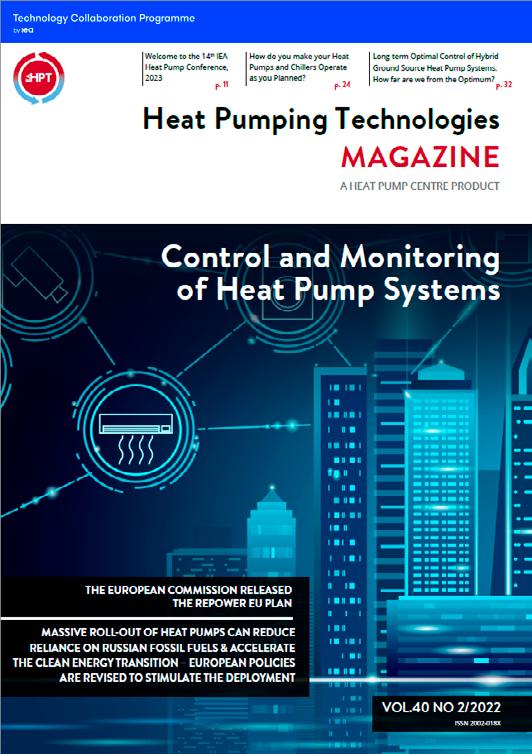
Figure 3. Oliver Sutton, BEIS provided un update on IEA HPT Annex 60.
Charlotte Shields, final year ERBE Ph.D. researcher, gave the last presentation focused on research on the interac tion of people and heat pumps from real installations. She used the four phases of domestication theory to demon strate the transition from boilers to heat pumps. Using the domestication phases, she related the appropriation phase to consider having a heat pump, the objectification phase to acquiring a heat pump, the incorporation phase to living with the heat pump and the conversion phase to enjoying having a heat pump. Her methodology consists of conducting interviews with the adopter and nonadopter, householders, non-adopter survey and review of actors' online materials (link to full presentation).
At the same time as the Magazine is launched, the Heat Pumping Technologies Newsletter is distributed. The Newsletter contains shorter versions of the Magazine articles with links to the full Magazine and is a good reminder that there is a new Magazine issue to read. In between the launch of the Magazine, the Newsletter is released on a monthly bases, summarizing some of the most interesting news within the field.
Read our Magazine and become a subscriber at: https://heatpumpingtechnologies.org/the-magazine/
Every three years, the Technology Collaboration Programme on Heat Pumping Technologies by IEA (HPT TCP by IEA) convenes the IEA Heat Pump Conference. The Unit ed States is proud to announce that it will be hosting the upcoming 14th IEA Heat Pump Conference, which will be held in Chicago on 15-18 May 2023. The theme for the Conference is “Heat Pumps – Resilient and Efficient”.

Clean, efficient, and reliable energy systems are essen tial to meeting basic needs for comfortable, secure, and environmentally friendly building environments, food processing, transport, storage; and industrial process es. Many analysts estimate that it will not be possible to achieve long-term climate, security, and energy goals without increasing the use of renewable heating and cooling technologies in conjunction with large-scale refur bishment and renovation of the world’s existing buildings and industrial infrastructure. Heat pumps, driven with renewable power sources, are the key technical solution for meeting these challenges.
The upcoming 14th IEA Heat Pump Conference will serve as a forum to discuss the latest heat pumping technolo gies and applications, and exchange valuable knowledge in research, market, policy, and standards information on related technologies. Exhibitions will be held during the Conference to share heat pumping products and technol ogies.
The National Organizing Committee (NOC), chaired by Brian Fricke, looks forward to providing conference attendees with an exceptional conference experience, in keeping with the tradition of excellence established by all 13 of the preceding conferences.
Conference program highlights include the following:
» High level invited speakers for the opening plenary sessions
» High level invited keynote speakers leading each major conference oral technical session
» Poster presentation sessions associated with each oral technical session
» Exhibition of equipment and information kiosks
» Technical visits
» Social and sight-seeing program
The Conference will start on Monday (15 May 2023) with a series of Workshops on international collaborative projects (Annexes) within the HPT TCP by IEA and other related topics. After the main plenary opening sessions on Tuesday morning (16 May 2023), the remaining two and one-half days will consist of oral and poster technical sessions organized in parallel tracks, featuring a number of heat pump related topics including, but not limited to, the following:
» Residential and commercial building comfort condi tioning, focusing on topics such as: space heating, air-conditioning, net-zero buildings, renovation, hybrids, domestic hot water, and multifamily build ings.

» Non-residential applications, focusing on industrial heat pumps, waste heat, district heating, commer cial refrigeration, and transport air conditioning and refrigeration.
» Innovation and Research and Development (R&D), focusing on aspects such as ground sources, advanced storage systems, working fluids, sorption technologies, advanced vapor compression, non-va por compression technologies, smart grids/ener gy, cold and hot climate applications, advanced air
conditioning technologies, gas-driven heat pumps and combinations with other renewable technologies.
» Policy topics and market status, trends, strategies, and future opportunities.
The wide variety of heat pump related discussions that will take place during the Conference is intended to attract a diverse group of attendees, including:
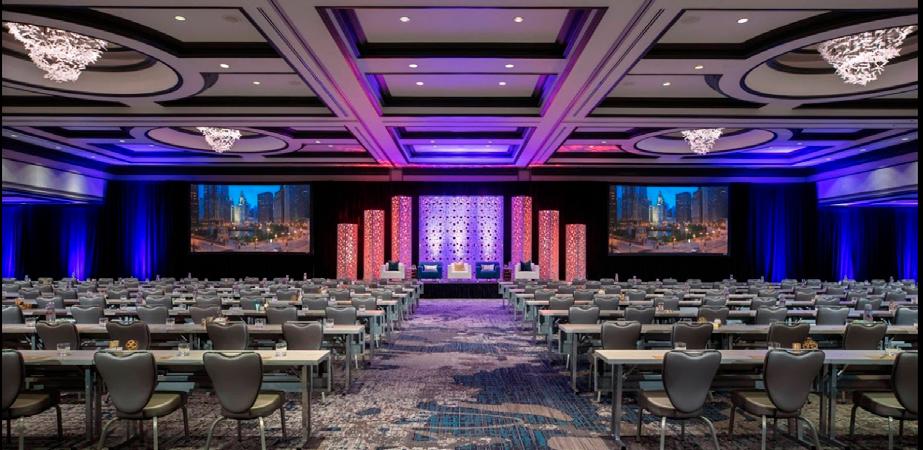

» Policy makers, government officials, energy efficien cy program leaders
» Executives and representatives from industry, utilities, and the public sector
» Manufacturers, distributors, and technology supporters
» Designers and developers of heat pump systems and components
» Researchers from industry, utilities, academia, and private and public R&D institutes
Those wishing to attend the Conference should visit the conference website: www.hpc2023.org. Detailed infor mation, including registration and hotel accommodation forms, will be available together with a second announce ment soon.

The Renaissance Chicago Downtown Hotel is excited to welcome the 14th IEA Heat Pump Conference attendees, “Resilient and Efficient.” Located in the prime area of the Theater District, the venue provides attendees with easy access to Chicago’s vibrant cultural infrastructure, includ ing a wide variety of traditional pubs, eclectic bars, and clubs. Chicago is also home to a wide variety of restau rants satisfying most any culinary desire. The Chicago O’Hare International Airport (ORD) and Midway Interna

tional Airport (MDW) are international and domestic arrival hubs offering light rail service to downtown Chicago, and ground transportation such as taxis and ride-share services are readily available.

Additional updates and details will be provided on the website of the conference www.hpc2023.org and via www.heatpumpingtechnologies.org.
» Abstract submission opened 15 November 2021
» Abstract submissions due 15 June 2022
» Authors advised of acceptance 31 July 2022
» Full paper submissions due 15 November 2022
» Final paper submissions due 15 February 2023
Close to 300 abstracts accepted for the conference
The projects within the HPT TCP are known as Annexes. Participation in an Annex is an efficient way of increasing national knowledge, both regarding the specific project objective, but also by international information exchange. Annexes operate for a limited period of time, and the objectives may vary from research to implementation of new technology.
IT,
DE, FR, IT, JP, KR, SE, US INTERNET OF THINGS FOR HEAT PUMPS
DE, DK, FR, NO,
, DE, FR, NL, SE HIGH-TEMPERATURE HEAT PUMPS
AT, BE, CA, CH, DE, DK, FR, NL, NO, JP HEAT PUMPS FOR DRYING
AT, CN, DK RETROFIT HEAT PUMP SYSTEMS IN LARGE NON-DOMESTIC BUILDINGS
HEAT PUMPS IN POSITIVE ENERGY DISTRICTS
NEW
AT, UK, IT
AT, CH, DE, JP, US
The Technology Collaboration Programme on Heat Pumping Technologies participating countries are: Austria (AT), Belgium (BE), Canada (CA), China (CN), Czech Republic (CZ), Denmark (DK), Finland (FI), France (FR), Germany (DE), Italy (IT), Japan (JP), the Netherlands (NL), Norway (NO), South Korea (KR), Sweden (SE), Switzerland (CH), the United Kingdom (UK), and the United States (US).
Bold, red text indicates Operating Agent (Project Leader).


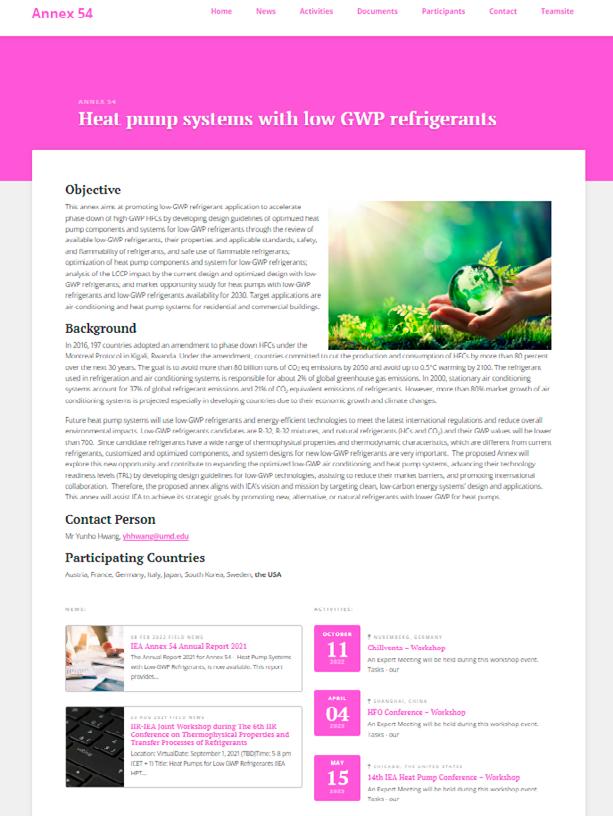
Heat pump-based heat supply at high tempera tures has considerable potential for decarbonizing the industrial process heat supply but is often fac ing various challenges. Exploiting the full potential of high-temperature heat pumps (HTHP) requires a common understanding of the technology, its potential, and its perspectives at a variety of stake holders. High-temperature heat pumps are consid ered a key technology for decarbonizing industrial process heating towards 2030, while a successful wide-scale implementation of the technology will require the consideration of technologies that are currently approaching the market and still under development.
Therefore, this Annex gives an overview of available technologies and close-to-market technologies and outlines the need for further RD&D develop ments. In order to maximize the impact of hightemperature heat pumps, this Annex also looks at process integration by developing concepts for heat pump-based process heat supply, and the implementation of these concepts see Figure 1.
The overall objective of the Annex is to provide an overview of the technological possibilities and applications as well as to develop best practice recommendations and strategies for the transition towards heat pump-based process heat supply.
The intention is to improve the understanding of the technology’s potential among various stakeholders, such as manufacturers, potential endusers, consultants, energy planners and policymakers. In addition, the Annex aims to provide supporting material to facilitate and enhance the transition to a heat pump based process heat supply for industrial applications.
This will be achieved by the following sub-objectives:
» Provide an overview of the technology, including the most relevant systems and components that are commercially available and under development (Task 1 – Ongoing).
» Identify technological bottlenecks and clarify the need for technical developments regarding components, working fluids and system design (Task 1 – Ongoing).
» Present best practice system solutions for a range of applications to underline the potential of HTHPs (Task 2 – Ongoing).
» Present strategies for the transition to heat-pump based process heat supply (Task 3 – Planned).
» Enhance the information basis about industrial heat pumps, potential applications and potential contribution to the decarbonization of the industry (Task 1, 2 & 3 – Ongoing).
» Develop guidelines for the handling of industrial heat pump projects with a focus on the HP specifications and the testing of these specifications (Task 4 – Planned).
» Disseminate the findings to various stakeholders and add to the knowledge base for energy planners and policy makers (Task 5 – Ongoing).
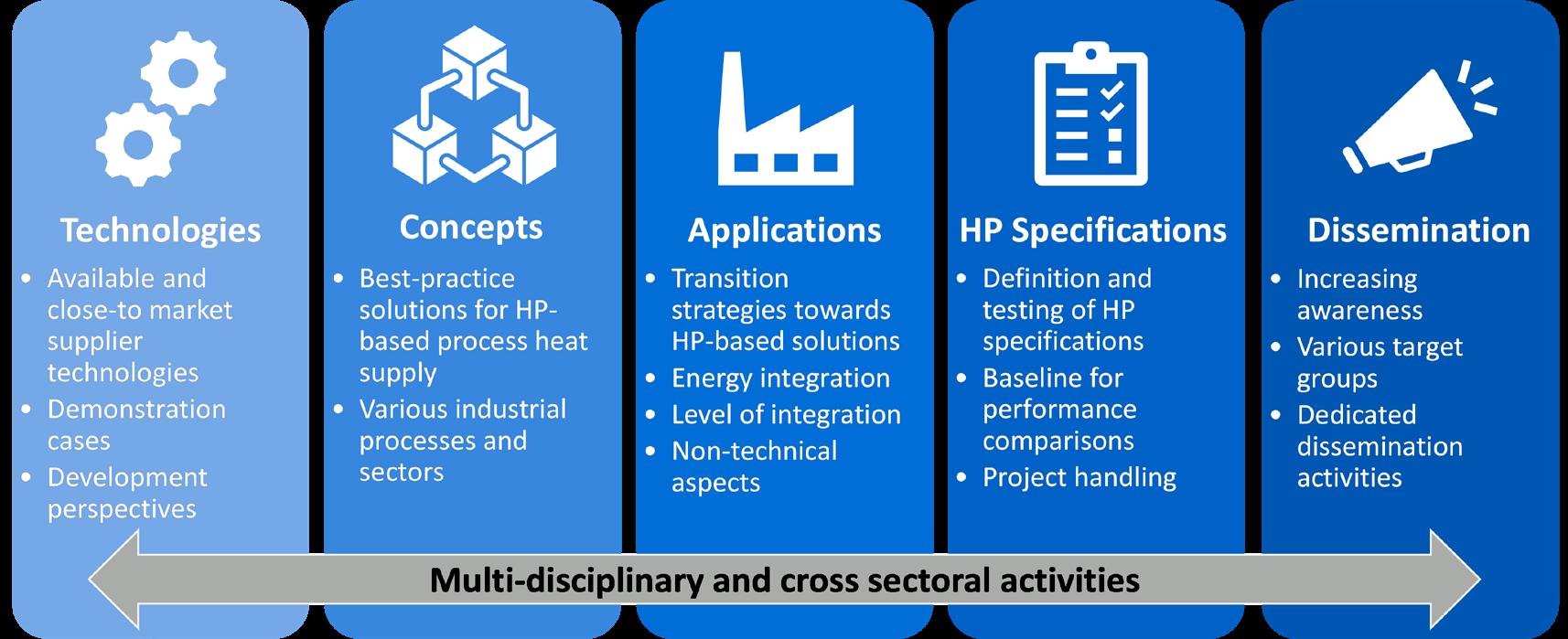
» Project duration: Jan 2021 – Dec 2023
» Operating Agent: Danish Technological Institute, Benjamin Zühlsdorf, bez@dti.dk, +45 7220 1258
» Participating countries with national representatives in brackets: Austria (AIT and TU Graz), Belgium (University Ghent, KU Leuven), Canada (National Resources Canada, University of Sherbrooke, Emerson), China (University of Chinese Academy of Sciences), Denmark (DTI, DTU, Rambøll, Viegand Maagøe, Fenagy, Johnson Controls), France (EDF), Germany (DLR, Fraunhofer ISE and University of Paderborn), Japan (CRIEPI), Netherlands (TNO), Norway (SINTEF), South Korea (Korea Institute of Energy Research), Switzerland (Fachhochschule OST, EPFL)
» Further countries are preparing their participation, including UK and US.
» Website: https://heatpumpingtechnologies. org/annex58/
High-temperature heat pumps (HTHP) are attracting growing interest and are considered a key technology for decarbonizing industrial process heating. The recently published IEA report “Net Zero by 2050 – A Roadmap for the Global Energy Sector” outlined the importance of industrial heat pumps and concluded that heat pumps should cover 15% of the process heat demand of light industries at temperatures up to 400 °C, while this share should increase to 30% by 2050. This corresponds to
a required installation capacity of 500 MW per month over the next 30 years. The majority of these systems are expected to have supply temperatures above 100 °C and are accordingly considered high-temperature heat pumps.
The relevance of high-temperature heat pumps is confirmed by the large interest in the Annex 58. Ten countries have already confirmed their participation, and in total, up to twelve participating countries are expected to join the Annex. The national support groups comprise R&D institutes and universities, technology suppliers, consultants, and others and are accordingly supplemented with knowledge from various national and international R&D projects.
As part of Task 1, the activities focused on summarizing the state of the art, including available and close-tomarket technologies. In this activity, information about supplier technologies and demonstration cases were collected using review templates. In the general per ception of the industrial heat pump industry, supply temperatures of commercially available equipment seem to be limited to around 100 °C, while first technol ogies are becoming commercially available for higher temperatures. In order to communicate the availability of technologies, the Annex has collected information about supplier technologies and demonstration cases in informative two-page brochures, as shown in Figure 2.
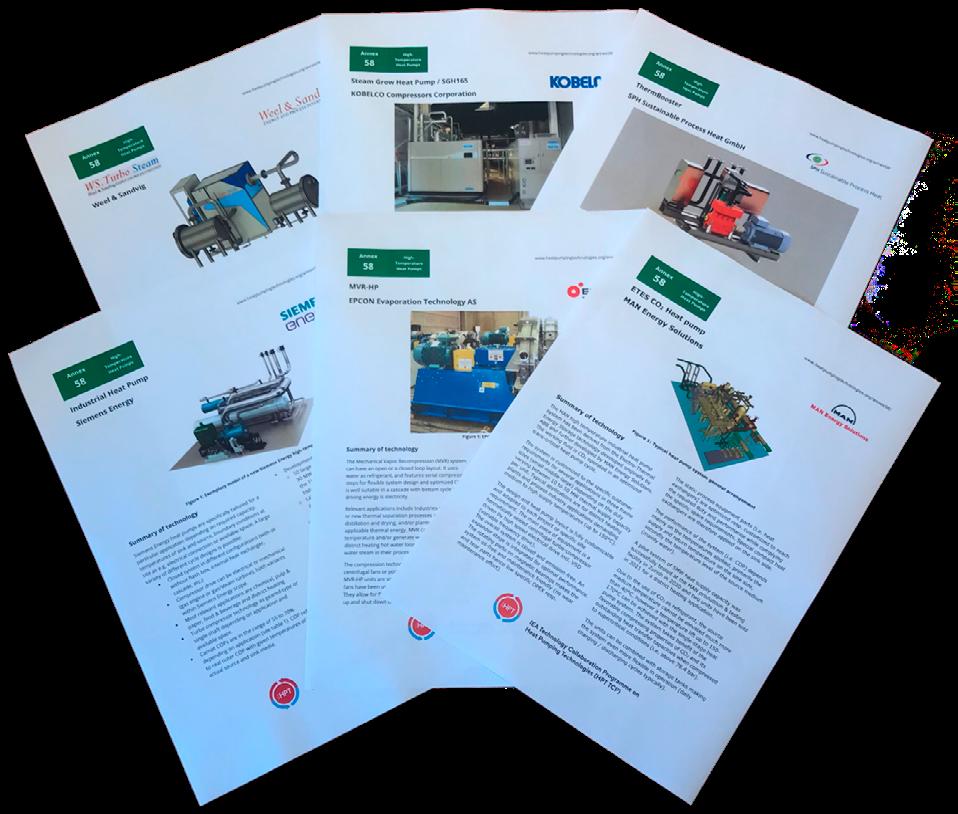
By now, 33 supplier technologies were described, while information could be gathered for 14 demonstration cases. These descriptions are published at the Annex 58 home page (https://heatpumpingtechnologies.org/an nex58/task1/) and publicly accessible. The report about Task 1 with a more detailed analysis is expected for the end of 2022.
Figure 2. Two-page information brochures of high-temperature heat
Climate change is rapidly progressing, and many institutions and cities worldwide declared a climate emergency. The built environment is a key sector for fast emission reduction in many countries. For instance, 36% of the emissions in the EU are due to buildings, so reaching ambitious climate targets will be strongly facilitated by transforming the building sector.
While in the new built sector, nearly zero energy re quirements have been introduced in the EU by the beginning of 2021 for individual buildings and are to be introduced in North America and Asia, as well, positive energy buildings could be the next ambi tious target. But, the on-site energy production is limited for individual buildings. Extending the sys tem boundary to districts enables to benefit from synergies of the different load profiles of consum ers and can facilitate to reach a positive energy/ emission balance.
Due to their unique features, heat pumps are a very favourable technology in positive energy districts.
They have a high energy performance, can produce heating and cooling energy even at the same time and can recover heat for other building services. They can also link the on-site electricity production to space heating and cooling loads, thereby provid ing energy flexibility within the district or for con nected grids.
Annex 61 will investigate heat pump application in building clusters and districts for both new and retrofit districts on a technical, economic and eco logical basis. Results are used by building system technology designers and urban planners as well as by utilities and ESCO (Energy Service Companies) looking for new business opportunities. Based on the results, heat pump manufacturers can tailor and further develop their products for building clusters and district applications. Policy makers get evalua tions to shape future ambitious energy targets.
» Characterise the state-of-the-art of heat pump application in positive energy districts in the participating countries
» Develop generic system concepts for the integration of heat pumps in districts
» Perform techno-economic analyses of promising concepts by simulation
» Evaluate the real performance of heat pumps in districts by monitoring projects
Table 1. Possible contributions of the interested and participating countries
AT UIBK, AIT, AEE-intec
BE ULB, KU Leuven, Swecobelgium, Vito
CA Concordia
CH IET OST
DE THN, SIZ energie plus
IT Univ. Firenze
JP Univ. Nagoya
NL EnergyGo; RVO
NO SINTEF, NTNU, COWI
SE RISE, Univ. Lund
US NIST, ORNL, EPRI
• Concept for 7 equal multi-family houses (MFH) by simulation/monitoring
• Evaluation of HP in clusters of buildings (decentral, semi-central, central)
• Design, simulation and monitoring of clusters of offices and neighbourhoods with sewage water heat source
• Clean cluster concepts for dedicated load situations
• HP in a retrofitted neighbourhood to plus energy level
• Case studies of positive energy neighbourhoods by simulation
• Simulation and monitoring of positive energy neighbourhood
• Design of larger heat pumps for MFH and clusters of buildings
• Model predictive control of 8 single-family houses for energy flexibility
• (Retrofit) concepts for MFH/neighbourhood by simulation and monitoring
• Monitoring and simulation of neighbourhood with seasonal thermal storage, HP and solar collectors/troughs
• Evaluation of contribution of HP in positive energy district to reach climate protection targets
• Case studies of simulation and monitoring of HP in districts
• Investigation of decentralised and centralised system concepts for HP in new built and retrofit application
• HP application in clusters of buildings and districts
• Monitoring of HP in mixed-use district
• Collective ground-coupled heat source systems for cluster of buildings
• HP modelling and development for the use in thermal grids
• Control of HP flexibility in thermal grids and large-scale control of HP
• Simulation, testing and monitoring of high-performance ground source integrated HP with different ground-source systems (horizontal/borehole)
» Project duration: Sept. 2022 – Dec. 2025
» Operation Agent: Carsten Wemhoener, Institute of Energy Technology, Eastern Switzerland University of Applied Sciences
» Participating countries: Austria, Belgium, Canada, Germany, Japan, Netherlands, Norway, Sweden, Switzerland, USA (boldletters received)
» Website: https://heatpumpingtechnologies. org/annex61/
Annex 61 is a new Annex officially started in September 2022 in order to investigate heat pump application as well as design and control in positive energy building clusters and districts. In 2022 two working meetings were held. On the first (online) meeting in March, the contributions of the participating and interested coun tries were presented and are summarised in Table 1. Moreover, the objectives and the scope were discussed.
On the second (on-site) meeting at the University of Inns bruck, and first results of Task 1, State-of-the-art anal ysis have been presented, and Task 2 on generic heat pump system concepts have been prepared. Regarding the state-of-the-art positive energy, districts are an am

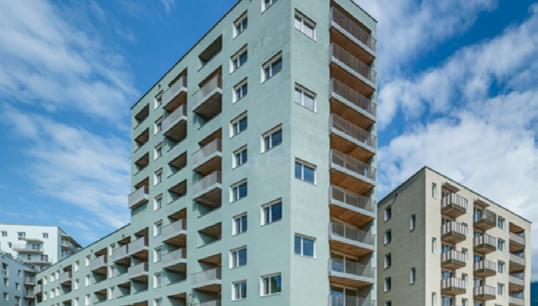


bitious energy target, and only a few districts in the par ticipating countries were realized. On the national level, however, different definitions, boundary conditions and criteria exist, e.g. the 2000-W-certification for districts in Switzerland also includes the embodied energy and the building-induced mobility in the balance, while in other countries, the focus is on operational energy. With re spect to the methodology, it was discussed to evaluate what level of plus energy districts can be reached or what deficit has to be overcome if the plus energy bal ance is not reached.
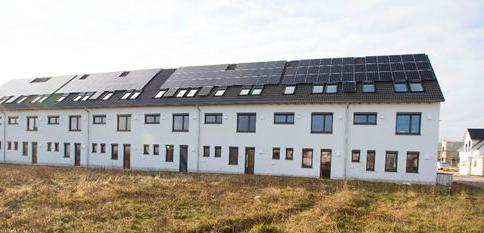
Regarding the generic system concepts in Task 2, the heat pump integration in the district has been catego rized from a decentral integration on the individual building level in different steps to a centralized integra tion. The easiest connection among buildings in a cluster is a purely electric connection enabling higher self-con sumption and energy flexibility. A further group of inte gration options is thermal integration on the source side. Moreover, decentralized and centralized integration can be combined, e.g. based on different building services as central heating and decentralized domestic hot wa ter. The entirely central integration would be a heating central for all building services. Figure 2 depicts the in tegration option linked to field monitoring projects con tributed by Annex 61 participants.
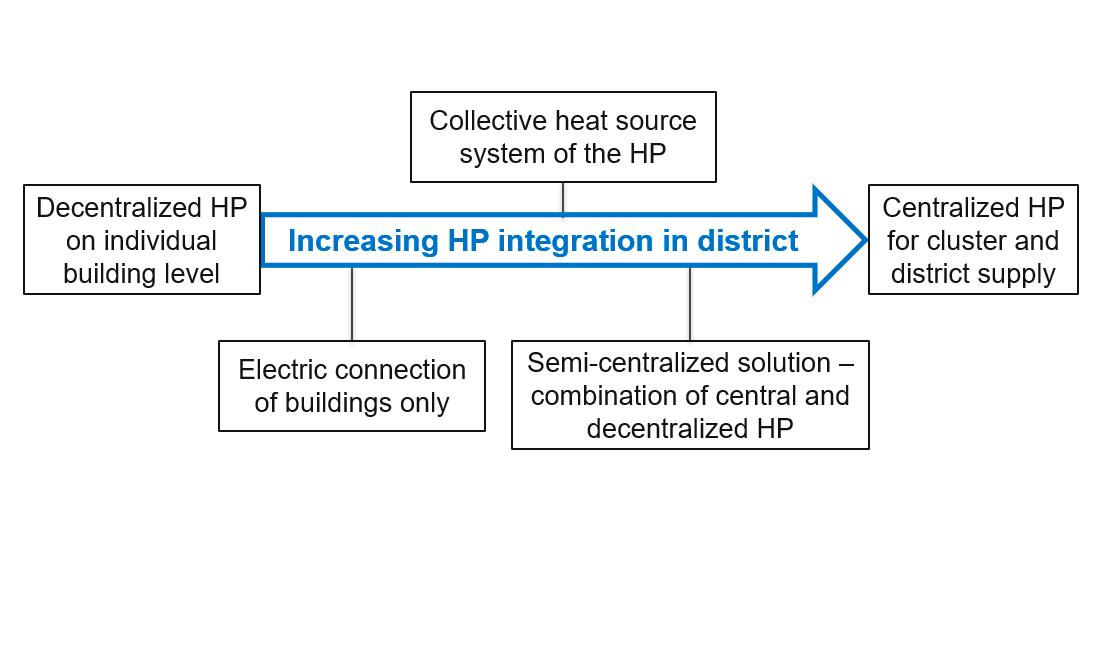
Heat pumps are already today the number one technology in new, typically single-family houses, in a number of countries. As regards multi-fam ily buildings, there exist good examples of heat pumps implementation, however, it is not yet a widely chosen solution. At the same time, there is an ongoing trend for migration to high-den sity cities and, consequently, the significance of multi-family houses is on the rise. In the light of
the above, there is a strong need to search for and to provide optimal solutions for heat pumps implementation in high-density cities, with the focus on new and existing multi-family buildings.
For further information, please contact Marek Miara, marek.miara@ise.fraunhofer. de.
This new Annex will focus on the placement impact on Heat Pump Acoustics to further re move acoustic market barriers establishing and fortifying heat pumps as the number ONE choice as renewable energy and energy efficiency option for HVAC applications.
A new IEA HPT Annex, “Placement Impact on Heat Pump Acoustics”, is building upon the groundwork of the recently finalized IEA HPT Annex 51 “Acoustic Signatures of Heat Pumps”, conducted by Austria, Denmark, Germany, France, Italy, and Sweden. Primarily focused on heat pump placement, it leaves room for special topics of heat pump acoustics, covering selected applications and the refinement of methods.
Several fields of interest have been identi fied in the course of discussions in the final phase of Annex 51; the main objective from IEA HPT Annex 51 remaining is to further remove acoustic market barriers to establish and fortify heat pumps as the number ONE choice as renewable energy and energy ef ficiency option for HVAC applications. Intense discussions, however, emphasized that avoiding show-stoppers to the rapidly growing deployment of heat pumps is gaining significance. Therefore, consumer boards will be screened to identify the challenges in the field. Furthermore, as the cooling capability of heat pumps gets more and
more important, this Annex will include the acoustics of heat pumps in cooling modes in its focus.
Revision of cases of complaints showed, that each placement situation is unique and that sev eral aspects contribute to a successful installa tion. Therefore, as a proper installation is key to low acoustic impact on the environment, the existing guidelines will be revised and linked to the developed placement tools.
Thus, the follow-up to and continuation of Annex 51, “Acoustic Signatures of Heat Pumps”, will work on:
• Building Acoustics Impact of Heat Pumps
• Urban Acoustics Impact of Heat Pumps
• Psychoacoustics of Heat Pumps
• Digitally Assisted Heat Pump Placement
• Dissemination of the results
We cordially invite you to join the newly proposed Annex, which is intended to take off in January 2023 for a runtime of 3 years and will be coor dinated by AIT, Austria. The finalized legal text is available from the representative from your country
For further information, please contact christoph.reichl@ait.ac.at. We also invite you to join a Q&A mid of December; its invitation is being distributed by the Heat Pump Centre.
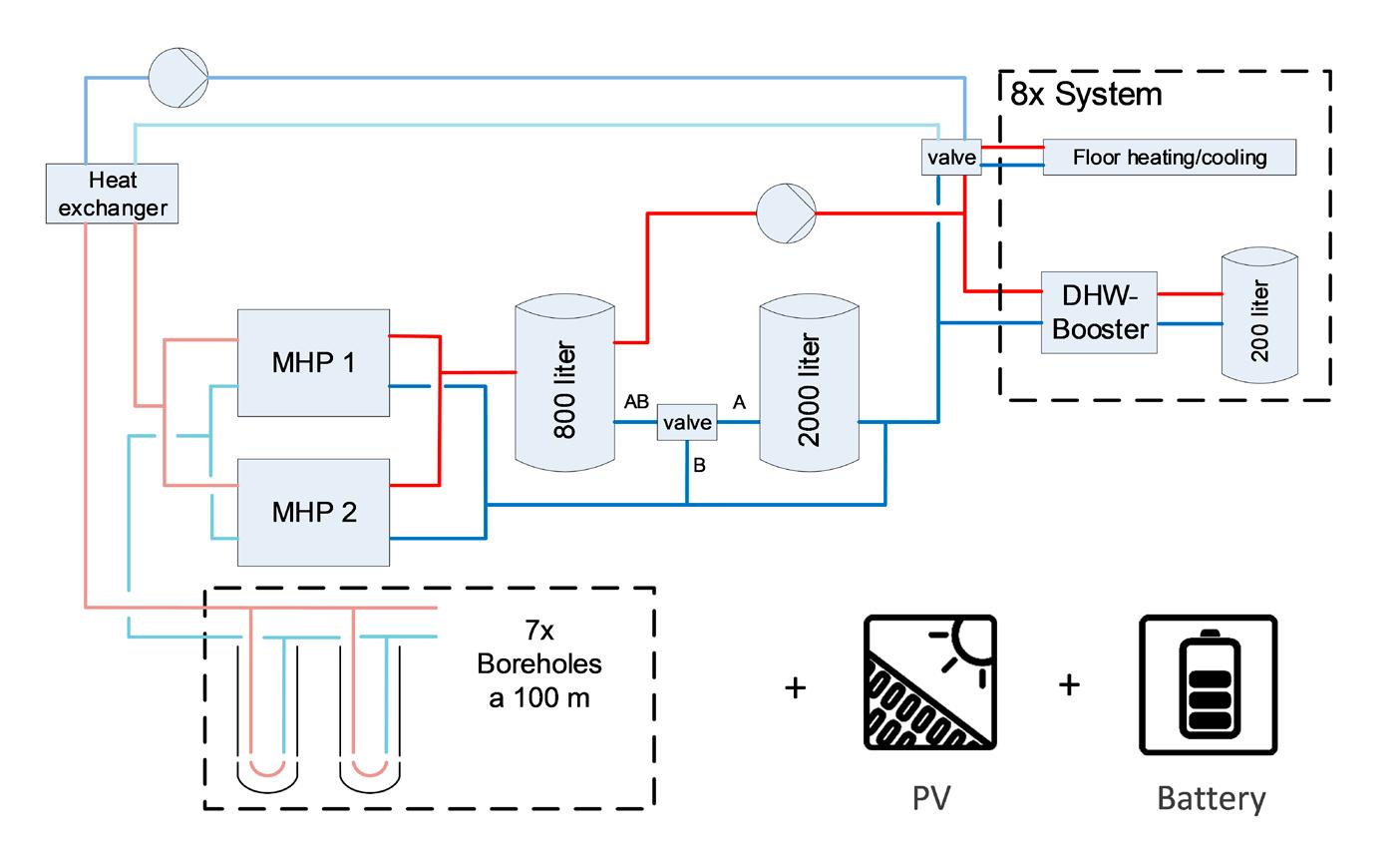
The integration of heat pumps into a PV and battery system faces the challenge of sharing the available PV power among the actors. In order to coordinate this competition, a suitable energy concept, as well as the control, must match. In a cluster of eight terraced houses, an energy system has been implemented, which should represent a smart integration of heat pumps. To coordinate the interaction of the components, model predictive controls are used. The simulation shows very good results for the predictive controls, but the results cannot be replicated in total practice.
The cluster of eight terraced houses is located in Herzo genaurach (Germany) in the new district of Herzo Base and was built in 2017. The buildings were designed as "all-electric buildings", which means that the core source of energy is electricity. A PV-system (88 kWp) on the roofs delivers an annual surplus of energy. The terraced hous es share a central heat pump system of two modulating heat pumps (MHPs) of each 16 kWth, with a geothermal heat source as well as a battery system with a capacity of 40 kWhel. The supply of domestic hot water is decentral ized in each terraced house by a domestic hot water-HP (Booster), which uses the heating buffer storage units as a heat source. The energy system is illustrated in Figure 1. All 8 terraced houses are equipped with floor heating and decentralized ventilation devices.
The idea of small neighbourhoods creating an energy community and sharing energy systems enables a high
er potential to increase the PV self-consumption. Fur thermore, synergies between different electrical loads lead to a more even electrical profile and reduces elec trical load peaks. To tap this potential, smart integration of heat pumps into the energy system is necessary. Predictive control strategies, in particular, can contrib ute to an objective-oriented response to fluctuating PV generation. They enable efficient use of PV generation and increase the efficiency of the heat pumps. Similarly, available PV power can be targeted to heat pumps and storage systems to prevent competition for power [1]. Various controls were developed and tested in the ter raced houses to evaluate their potential to increase PV use, efficiency, and operating costs. Besides two rulebased controls, a Model Predictive Control (MPC) and a simplified predictive control (SPC) are implemented. Monitoring has been carried out since April 2018 to eval uate the control strategies and the energy system.
The standard operation in the energy system of the terraced houses is a PV-optimized control (PVC), which charges the thermal storage units up to a higher tem perature level during PV generation. The PVC was fully commissioned in the second monitoring year in 2019. Thus, in the first monitoring year, the heat pumps were operated by a heat-controlled (HC) operation. In the monitoring years, PV generation has slightly decreased, and consumption has increased (see Figure 2). The in crease is mainly due to household electricity and e-vehi cles. Direct PV consumption and battery discharge have also increased and, most recently, by 16% compared to the 1st monitoring year. The increase in the 2nd monitor ing year was quite high at 13% and remained the same
in the 3rd monitoring year. This increase is partly due to the general increase in consumption but also due to the implementation of the PVC at the end of the 1st mon itoring year. The simulation of the energy system with the PVC was implemented in TRNSYS and simulated with measured values from 2019. The simulation results show a higher load cover factor (LCF) of 68% and a sup ply cover factor (SCF) of 42%, which mainly results from a higher battery charge and discharge.
In order to introduce predictive control strategies, in the first step, a simulation study was carried out. In the second step, the control strategies were implemented in real in the terraced houses [2].
Figure 2. Results of simulation and monitoring years
For the simulation of the control strategies, measured data of the energy system of the terraced houses for the year 2020 is used. The simulation study was carried out in the MATLAB software. The rule-based approaches in clude the HC and the PVC. For the use of the predictive controls, MPC and SPC, forecasting models, which were realized by artificial neural networks (ANN) in Python with the library Tensorflow, are used to generate the thermal and electrical load forecast. The MPC approach is real ized by a mixed-integer linear programming (MILP). All energy models are based on energy flows coupled in an energy node to receive linear models. The SPC uses the forecasting models as well as energy balancing to deter mine the heat pump operation and the state of charge of thermal storage units throughout the day.
The results of the simulation study are shown in Figure 3. The simulation of the control strategies shows that due to the large PV production, a very high PV self-consump tion is already achieved in HC operation. Advanced con trol strategies, like MPC, increase the load cover factor by only 2% to 3% percentage points. Energy cost sav
ings can be achieved, especially by MPC, by up to 34% compared to an HC operation. Even though PVC and SPC have slightly higher energy consumption, the oper ating costs are less due to the use of PV. Although the differences between PVC and SPC are small, favourable results are shown for the predictive approach. In addi tion to operation at PV production, efficient operation with high COP at partial load is crucial for energy cost savings.
To test the control strategies in real operation, the MPC and SPC are implemented in the real energy system of the terraced houses. Since December 2020, the energy system has been operated with the MPC and SPC in sec tions over several weeks. The process of MPC and SPC differs from PVC because an operating plan is created, which is passed on to the heat pumps. The operating plan of the MPC is created every hour, while the operat ing plan of the SPC is created only once a day at 6 am. For the comparison, MPC operation was tested for 42 days, and SPC operation was tested for 20 days during the winter of 2021 and 2022.

The real operation of the MPC and SPC shows that devi ations in the prediction and modeling, as well as the in terpretation of the setpoint from the online simulation, lead to different results in real operation. The operating costs of online simulation and measurement show devi ations of – 64% and + 20% in the two predictive operat ing modes. In the case of MPC operation, the main de viations results from the PV prediction, which was 27% higher in the measurement, while energy consumption was only 15% higher. Thus, the feed-in bonus reduced the operating costs significantly.
The terraced houses present a smart integration of heat pumps into an energy system with PV and battery sys tem. Due to the smart and predictive controls, the avail able PV generation is allocated to the components, and the competition between consumers and various stor age units is coordinated.
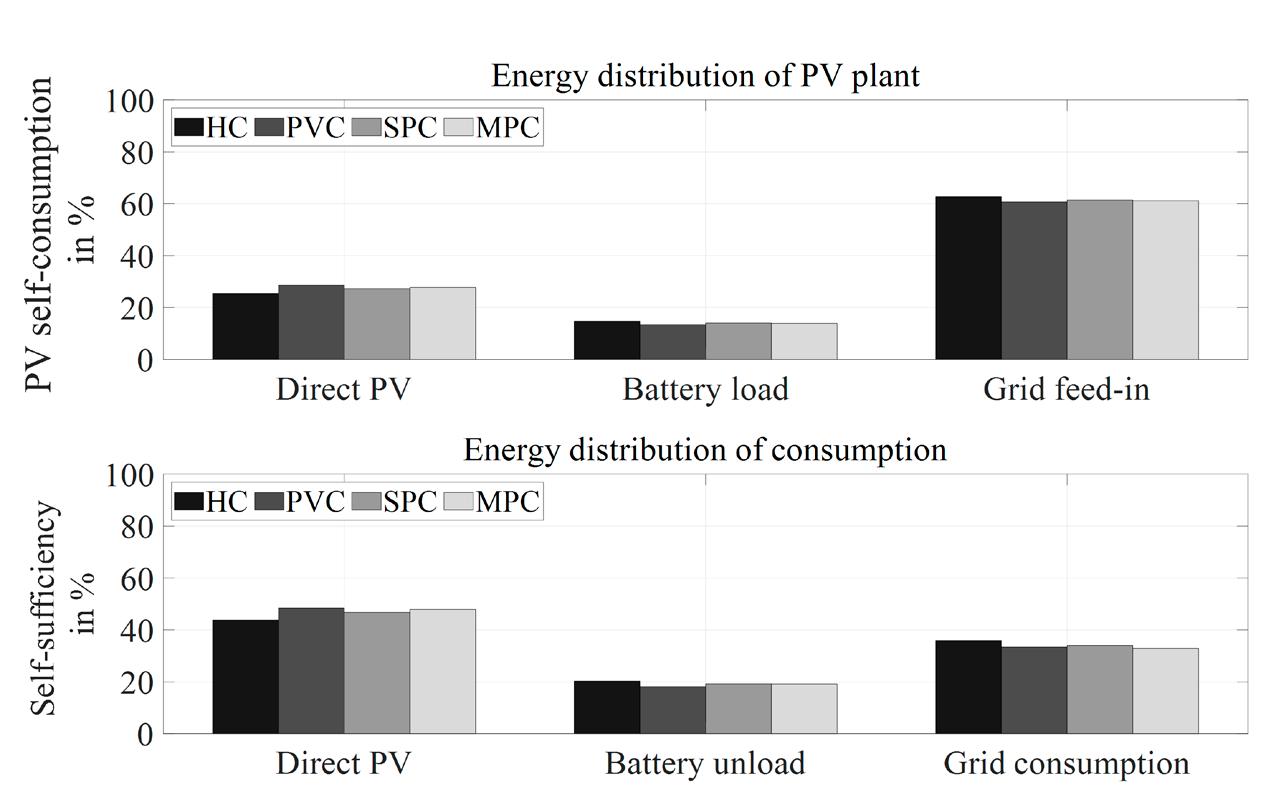
The simulation shows very good results for the predic tive controls, but the results cannot be replicated in practice. In the simulation, cost savings of up to 34 % can be achieved. In real operation, deviations of the op erating costs up to - 64% can be seen compared to the result from the simulation.
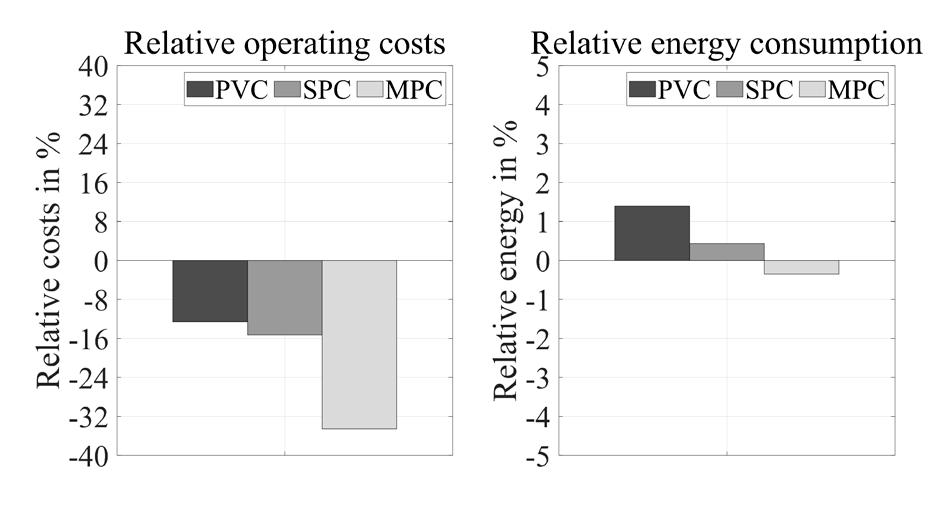
In real operation, differences between offline/online simulation results and measured data become appar ent. Since the setpoint specifications from the simula tion can only be transferred to the real heat pumps in the form of setpoint temperatures, the operating plan cannot be fully implemented. To resolve this conflict, a more open control would be desirable in the future. As well, deviations in the prediction, especially the weather prediction, lead to different results. In order to get an overview of the full potential of the predictive controls, a long-term operation is planned.
Technische
christina.betzold@th-nuernberg.de https://doi.org/10.23697/7mmf-3f37
The Energy Machines Verification tool (EMV) is a combined hardware/software solution based on physical measurements. A service REST API (REpresentational State Transfer Application Programming Interface) and thermodynamic models of the heat pumps in order to provide online/live transparent performance monitoring of these, as well as perform analysis on historically logged data. Here we present a case study where a combination of this tool and energy-meters are used on an existing plant to de-convolute the system COP and the negative energy balance of a borehole thermal storage (BTES), which may predict, and prevent potential long-scale temperature drops inside the BTES.
Energy Machines (EM) is a leader in the design, imple mentation and operation of integrated energy systems for buildings. EM uses standardized component designs, which not only reduce complexity for control systems but, more importantly, ensure quality and functionality as the designs consist of reusable and scalable modules. Through simulation platforms, EM is developing digital solutions for heat pump systems. Hence, EM has a key focus on the digitalization of heat pumps and is, in re lation to that, also a part of the Danish working group in the HPT Annex 56 on “Digitalization and IoT for Heat Pumps”.
Ground source heat pumps, which take advantage of borehole thermal storages (BTES), are some of the most flexible heat pumps which provide high energy efficien cy [1]. When designing a new BTES, care must be taken to avoid the dropping of temperatures below freezing. The lifetime of the underground storage is typically de signed for 25 years. In practice, this is controlled on-site by dumping excess building heat in free-cooling mode during spring/early summer and excess heat from the hot side into the borehole in warm summer months during active cooling. Thermal energy-meters can be placed around the site to estimate the power going into the boreholes, but they are expensive and in most appli cations, the energy meters are therefore limited to only measuring the building interface (heating/cooling side).
Here, we present a case study of an Energy Machines (EM) installation located in Sweden, where we wish to investi gate the total heating/cooling production from the instal lation, as well as examine the imbalance between heat storage and heat recovery from the BTES connected to this site. We do this by applying the Energy Machines Ver ification tool (EMV), in combination with the preexisting energymeters, to open up the “black-box” of the ener gy flows of the heating/cooling system. EMV relies on multiple, simultaneous measurements of the refrigerant
pressure and temperature, as well as a knowledge of the thermodynamic properties of that refrigerant, as illus trated in Figure 1. EMV comes as an optional “out-of-thebox” with all EM installations since the machines already have all the necessary sensors equipped. It functions primarily as an automated real-time cloud service but can also be invoked to analyze historical data and give inputs to energy engineers, building property managers, or others who might have an interest in the performance of their heating/cooling system.
The purpose of this study was to gain more insight into the performance of the EM installation, in particular with a focus on the total heat and cooling production vs the measured heating and cooling from the energy-meters, and the imbalance imposed on the borehole storage. This insight can improve the control of the system to prevent long-term freezing of the boreholes, as well as help, understand the actual system COP.
The system examined in this case study consists of three heat pumps (HP1, HP2, and HP3), two of which are in parallel, and one which has its heat source connected to the outlet of the two parallel ones. A very basic sketch can be seen in Figure 2. Currently, at the plant, thermal energy-meters are placed at the inlet, measuring Qi, build ing, as well as Qo, building. There are also electrical energy meters measuring the electrical power used for each of the three compressor pairs (Qc,1, Qc,2, Qc,3) (two circuits with two compressors/circuit each per heat pump). With EMV, we can estimate the power to the evaporator and the power released in the condensers. Because of the configuration of the system, only Qi,1 and Qi,2 need to be determined from EMV, as the input source to heat pump 3 is part of the output from heat pumps 1 and 2.
The EMV algorithm requires input measurements of pressure and temperature throughout the heating cycle,
p2,T2,1 p2,T2,2 p1,T1,2
p1,T1,1

Figure 1. p-h diagram for R410A, showing the thermodynamic cycle of the heat pump, indicating the necessary measurements of the temperatures/pressures for EMV. Energy Machines heat pumps have all relevant sensors installed per default, so the EMV option can be enabled without additional installations required.


which are logged with 1-minute resolution and are avail able using our energymachines.cloud platform, which logs and monitors all EnergyMachines installations. Figure 3 shows the energy flows in terms of heating and cooling in the system, as an example of the output data from EMV. Many more outputs can be derived, such as
COP, refrigerant flow and compressor efficiency, which given the right data analysis, may help diagnose/predict potential performance issues.
A summary of the COP, heating- and cooling energies can be seen in table 1, which is estimated by EMV, and
3000
20
15
2500
10
5
25 23/225/324/424/523/623/722/821/921/1020/1120/1219/118/220/319/4
2000
Heating Cooling Cummulative heating Cummulative cooling
1500
0
0
1000
500
3500 -5
accumulated energy (MWh) MWh/day Date
Figure 3. Heat (bold solid, red lines) and cooling (solid, blue lines) energy delivered per day (in MWh, left axis), as well as the accumulated energy (from start, broken lines right axis).
Table 1. Accumulated values for the case studied system calculated by EMV using temperature/pressure sensors located around the heat pump refrigerant circuit(s).
Heating energy delivered at condensers +subcoolers [MWh] Cooling energy delivered at evaporators [MWh] COP heating COP cooling 2928 2385 5.01 4.09
COP was calculated from the total compressor energy used, which was measured by electrical meters to be 584 MWh.
Table 2. Accumulated values for the case studied system calculated energy meters located at the building inter face (heating/cooling).
Measured heating energy delivered to building
Measured cooling energy delivered from building
COP heating
COP cooling / COP cooling energy balance 1815 699 3.10 1.20 / 2.10
COP was calculated from the total compressor energy used, which was measured by electrical meters to be 584 MWh. The energy balance is not fulfilled using energy meters alone because the borehole contributes significantly to the cooling energy delivered to the evaporators. COP cooling, therefore, has to be corrected for this (1.20 vs 2.10).
MWh/day
-20 -15 -10 -5 10
15
20
15
10
20 23/225/324/424/523/623/722/821/921/1020/1120/1219/118/220/319/4
1200.00 5
5
1000.00
800.00
800.00
1000.00 0
0
-5
-10
-15
600.00
600.00
23/225/324/424/523/623/722/821/921/1020/1120/1219/118/220/319/4
accummulated energy (MWh)
400.00
400.00
Charging Discharging
Charging Discharging Charging-discharging Cummulative charging Cummulative discharging
Charging-discharging
Cummulative charging
Cummulative discharging
200.00
200.00
1200.00 -20
accummulated energy (MWh) MWh/day Date
0.00
0.00
Figure 4. Borehole charging per day (left axis) from hot side (bold solid red line), discharging on the cold side (solid blue line) and the difference between the two (dotted black line) over a year of operation. In late spring, discharging is negative because of free-cooling, dumping energy back into the borehole from the cold side. During summer, charging is positive because of the active cooling demand of the building, which is when the heat pumps are mainly switched off. During autumn and winter, the borehole is discharged. Overall, the heat balance is negative, with higher discharging than charging (broken lines, right axis), not accounting for the selfcharge .from the rock surrounding the borehole).
similarly in table 2 using energy-meters only. A clear distinction can be seen. First of all, the energy estimated by energy-meters is much lower, and this obviously leads to a much smaller COP. This is particularly more clear for the cooling side since the difference between cooling energy determined by EMV and energy meters is much greater. The reason for this difference is the borehole storage, as well as the fact that some output energy from HP1 and HP2 is used as input energy for HP3 (cf. Figure 2). The result illustrates the difficulty in reporting a system COP, mainly because of the borehole storage but also because of heat recycling inside the system.
To gain further insight, we will combine the EMV results with the energy-meters (thermal+electrical) and use energy-balances that can be set up from Figure 2, which are shown in eq. 1 and 2. Figure 4 shows the borehole storage charging/discharging calculated by EMV, energymeters, and eqs. 1-2. The figure reveals how the bore hole is charged by free-cooling from the cold side in early spring, then via active-cooling from the hot side during the summer, before being discharged in autumn and winter to increase system performance by increasing the evaporator temperature. Overall, the energy-balance is negative, leading to a decrease over time in borehole temperature. Nevertheless, the borehole will also “re charge” through the surrounding rock, which requires
more detailed analysis using so-called “g-functions” [2]. This analysis was not done in this study.
TOBIAS DOKKEDAL ELMØE Energy Machines ApS Belgium
tobias.dokkedal.elmoe@energymachines.com https://doi.org/10.23697/j1x8-r288
The use of ground source heat pumps (GHSP) has increased in several regions of the world in the last 10 years as a response to reducing carbon emissions, but in Brazil, there are significant markets to be explored. There are some challenges that must be addressed, such as drill costs and unbalanced loads. This paper analyses these aspects and provides some directions to overcome those challenges.
Download and share this article
The use of GHSP has been a technological alternative to produce higher efficiency for air conditioning for cooling/ heating buildings coupled with the reduction of the carbon emissions from building operations. In Brazil, this sort of technology started to drive attention and become an alternative for reducing carbon emissions and was included as one of the strategies in the Brazilian Energy Plan for 2050.
Ground Source Heat Pumps (GHSP)
Ground source heat pumps can be divided into ones that transfer heat to or from the soil or aquifer. Also, if the heat transfer is done to or from the soil, they can be sub divided into a vertical bore, horizontal bore, trenched or slick loops (Figure 1).

When it comes to GHSP, which transfers heat to or from an aquifer, there are two wells that can be used: one to get low-temperature water, and the other to reject hot water (see Figure 2) or other water source (Figure 3).
Brazilian soil temperature and characteristics
The annual average ground temperatures are usually equivalent to the annual average air temperatures [1]. The ground temperature along the depth can be divided
into two regions, a zone in the shallow ground, where the ground temperature varies with the seasonal change and a zone in the deeper ground (a depth of more than ~10 m below the surface) where the ground temperatu re remains relatively constant [2,3].
Considering that the Brazilian climate is diverse, a ground temperature variation from south to north is expected. For this reason, the feasibility of GHSP may
Figure 2. GHSP loops the system with wells.
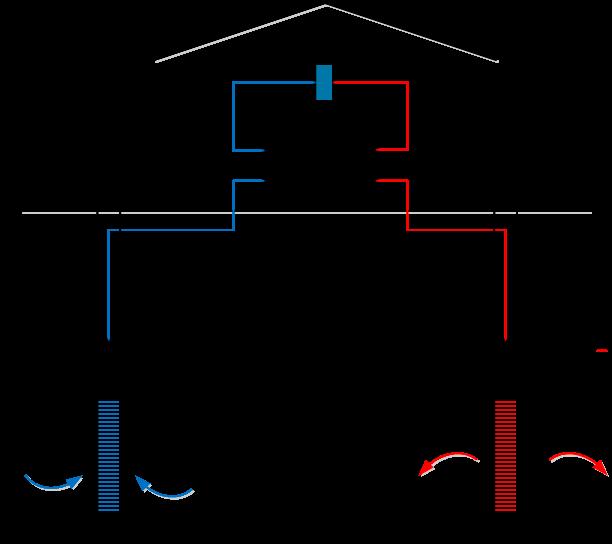
Figure 3. GHSP loops system in aquifers (lakes, rivers, or seas).

also be variable in this country. However, as commented in [3], in the tropics, the constant ground temperature in the deeper ground zone varies between 20oC and 25oC (locally even 28oC), which still permits the cooling of buil dings.
Another important local soil factor that influences the performance of the GHSP system is that unsaturated soils cover a large part of the Brazilian territory, and in these areas, due to the alternation of dry and rainy peri ods, the water content of the soils varies seasonally. As a consequence, the soil thermal conductivity, which is the most important thermal soil parameter [3], also varies seasonally, as observed experimentally in Morais et al. [4]. These authors found that the soil thermal conducti vity is higher during the rainy seasons and decreases in dry seasons and recommend that this seasonal variation should be considered in the design of GHSP systems.
The applications of GHSP in Brazil are limited to, so far, two projects in a residence, in a research center building (Centre of Innovation in Sustainable Construction) and in a soft drink plant, and there are two other projects that will be built in the next two years for two hotels in the southeast region of Brazil.

Regarding research and technical studies, there have been over 10 research projects mainly focused on tech nical feasibility studies of the implementation of GHSP in different regions and building typologies.



One of these research is done by Santos [5], where the author analyses the soil temperature distribution in the state of Paraná (south of Brazil) to evaluate the feasibility of implementation of GHSP in that region. The study pro vides the measurement of soil temperature distribution in specific sites in Paraná that ranges from 16°C to 23°C. Based on those measurements, an evaluation of the in crease of the COP for air conditioning is performed ba sed on the refrigeration cycle providing an average gain in the COP of 59%.

Another study was done by ICare [6], where a feasibi lity analysis of the implementation of GHSP was done for the South and Southeast region of Brazil, which con centrates the largest portion of the Brazilian population (56,5%) and gross national product (69,1%). This study evaluates the energy and water consumption for GHSP for 6 building typologies in the 7 state capitals of South/ Southeast regions. The evaluations were done using the simulation tool Energy Plus [7], where a comparison was done with the conventional air conditioning system for each typology, as shown in Table 1.

Table 1. Building typology and air conditioning systems.



This study shows that energy consumption has a signi ficant reduction, as shown in Figure 4, where the typo logies that provide the highest savings are hotels (43%) and shopping malls (54%). For the typologies using wa ter-chilled systems, there is also a considerable reduc tion in water consumption (from 40% to 60%) due to the elimination of the cooling towers from the system.
Despite the significant amount of energy and water savings, the cost to implement the GHSP is quite high, especially for the vertical loops, due to the cost of bore hole drilling. Therefore, the payback time for the analy sed typologies ranges from 10 to 15 years. Also, due to the Brazilian climate conditions, the need for cooling the building is much higher than heating. This imposes an unbalanced load on the soil, resulting in an increase in soil temperature close to the bore loops, reducing the efficiency of the GHSP system as well as its lifespan.

Studies are under development to deal with the high drill cost by analyzing the feasibility of using building piles to reject the heat to the soil. Regarding the unbalanced load, a feasibility study is under development to analyze the use of GHSP for cooling the building and producing heated water for showers, sinks or any process that re quires hot water (product sterilization).
Finally, regarding increasing the accuracy of the simula tion and the selection of GHSP and, therefore, a better design of GHSP systems, there is a lack of information related to the curves of the Coefficient of the Performan ce (COP) in partial loads and seasonal cooling/heating capacity of the GHSPs. This requires a joint effort of the
research groups and GHSP manufacturers to run stan dardized tests to evaluate such curves.
Studies show great potential for the applications of GHSP systems in Brazil, especially for the South and Southeast regions, with significant reductions of water and energy consumption in residential and commercial buildings.
There is a need for further analysis to reduce the high borehole drilling cost by using thermo-active ground structures (piles and retaining walls), which are already incorporated into the building construction. Also, there is a huge challenge due to the unbalanced loads that occur in Brazil due to its climate conditions (higher de mand for cooling) that can be addressed by using diffe rent GHSP configurations and a combination of energy supplies (heating and cooling).
Another important issue to be addressed is the lack of information on seasonal and partial load performance parameters of the GHSP, which requires a joint effort between research groups and the industry.
University of Sao Paulo – Department of Mechanical Engineering Brazil
ahneto@usp.br https://doi.org/10.23697/5rq3-k762
Equations rewrite the world around us in the language of mathematics. They are implemented in a lot of tools used by numerous scientists, engineers and practitioners. They are everywhere, and yet we sometimes forget to take a step back and look at these equations at face value. What can they teach us? In this article, we try to convince you of the beauty of borefield equations and how these equations on their own can help us to reason about the question of whether or not it is useful to divide a thermal load among two borefields.
Equations are useful. Any scientist or engineer will con firm this statement. Equations rewrite the world around us in the language of mathematics, so we can use them to solve problems. Hence, they provide a tool that we can use to learn about the world. But what about the equa tions themselves? Are the direct insights they offer often overlooked?
This article tells you the story of borefields, but now, the equations themselves are the protagonist. After more than 30 years of research into their mathematical com plexity and finding new ways to make them easier to compute, we pause and look at them directly. Can we still learn something from these 30 years old equations? Can we answer the question of how a thermal load should be divided among two borefields without doing detailed simulations?
History of the protagonist: g-functions
Borefields can be used to heat and cool our (residential) buildings in a sustainable way, by exploiting the heat/ cold in the ground. However, designing such borefields is quite challenging, since it is a three-dimensional tran sient heat transfer problem.
In 1987, Eskilson came up with the idea of g-functions to solve this complex problem [1]. g-functions show the temporal temperature evolution of the borehole wall for a constant heat extraction in a non-dimensional form. By applying temporal superposition of multiple constant loads to obtain the real borefield load, an accurate cal culation of the borehole wall temperature can be found. Figure 1 (left) represents the thermal step response of the borehole wall temperature when a constant heat injection is applied. This corresponds to the non-dimen sional g-function (in semi-log scale) on the right.
Thanks to these g-functions, it is possible to take into account both the internal thermal interactions between boreholes in a borefield and the external interactions with the surrounding ground. Previously, numerous dif ferent temperature penalties were used to obtain these interactions [2]. Although there is still a lot of research going on how to calculate these g-functions as fast as possible (see [3] for a novel development and [4] for a recent overview), our story starts from the original idea of Eskilson.
Eureka! The most wonderful thoughts of my life
The insights presented in this article originally arose from the question: If there are two borefields connect ed to each other, how should we divide the load of the consumers among both fields while minimizing the total borefield length (i.e. the sum of the length of all bore holes) [5]? As practitioners typically define the borefield cost based on the total borefield length, a minimal bore field length corresponds to a minimal investment cost. Without using detailed simulations, reasoning based on the g-functions helped us answer this question.
Let’s start with Figure 2 which represents the g-functions of a 10x12 borefield for multiple borehole depths. From these g-functions, the thermal resistance between the borefield and the surrounding ground (Ra) for a design period of 20 years can be derived. This thermal resis tance is linearly proportional to the difference in g-func tion values between two points on the horizontal axis, 20 years apart (as indicated in Figure 2). The reasoning in this article is based on the long-term effects only and hence takes only the yearly imbalance into account. Al though for design purposes peak loads are also import ant, they can be neglected (without loss of generality) for this exercise [5]. Note that the borehole depth is constrained by practical design limitations, i.e. a mini mum depth of 50 m and a maximal depth of 350 m are assumed. A g-function is a unique characteristic of a borefield and depends on the configuration and the depth of the boreholes. Given a defined configuration of the boreholes, the thermal resistance Ra of that borefield can be plotted as a function of the depth of the bore holes. This results in Figure 3 represent the resistance R a for different square borefields. This figure shows that for an equal borehole depth, more boreholes lead to a larger thermal resistance Ra meaning that it is more difficult for the borefield to exchange heat with the ground. This is because the boreholes in the borefield affect each other. The more boreholes, the more mutual thermal interactions are present.
Subsequently, it is possible to derive the relation be tween the depth of the boreholes and the imbalance at which a certain borefield reaches its design limits. This

Figure 2. g-functions of a 10x12 borefield for mul tiple borehole depths (ts=150/9ks, where ks is the ground thermal conductivity in W/mK)

Figure 3. Relation between Ra and borehole depth for multiple borefields
Figure 4. Relation between borehole depth and imbalance for multiple borefields
relationship is derived using the L2-sizing method (see Eq. 1) and is represented in Figure 4. In Equation 1, the qi ’s are heat pulses, the Ri ’s are thermal resistances (calculated with g-functions) and the Ti ’s are tempera tures (for more information we refer to [2, 5, 6]).
The yearly term qy .R y is significantly larger than the other terms, which justifies the simplification of neglecting the other terms. Figure 4, shows that for an equal borehole depth, the more boreholes, the more imbalance a bore field can dissipate in the ground. Note that the number of boreholes multiplied by the borehole depth gives the total borefield length, which scales with the imbalance.
From Figure 3 and Figure 4, it is possible to eliminate the depth variable and to compose a plot that represents the thermal resistance R a as a function of the imbalance. This results in Figure 5. Eureka! This graph gives useful insights into the design of borefields. Firstly, we see that the curves intersect each other, even though this is not the case in Figure 3 and Figure 4. This is because of the ratio between the total borefield length (a larger bore field length can dissipate a larger imbalance) and the surface-area-to-volume ratio of the borefield (a larger surface-area-to-volume ratio means less mutual ther mal interactions). Secondly, we can answer the question posed in the introduction of this article: If there are two borefields connected to each other, how should we di vide the load of the users among both fields while min imizing the total borefield length? This question can be discussed for two cases; the case with two identical bore fields and the case with two different borefields.
Two identical borefield configurations
Consider a situation where a thermal load is coupled to two identical borefield configurations. The question now is whether it is better to divide the load equally among both fields or not. The answer can be found in Figure 6, which is a general representation of the thermal resis tance R a as a function of the imbalance. If the load is divided equally, both fields experience an imbalance I and consequently have a thermal resistance Ra. Imagine now that part Q of the imbalance I is shifted from the first to the second field. Then, the first field experiences an imbalance I-Q and the second field an imbalance I+Q The thermal resistances are Ra,2 and Ra,2’ respectively. The average thermal resistance Ra’ is now smaller than the thermal resistance R a for a borefield experiencing an imbalance I, so one would expect a smaller borefield length, right? However, one should look at the total bore field length (as we are minimizing this value). From Equa tion 1, we know that the thermal resistance is weighted with the imbalance. Hence, the total borefield length in the unequal case L22’ is always larger than the borefield length in the equal case L11, because
This means that an equal division of the imbalance is always better than an unequal division [5].

Two different borefield configurations
It could also happen that two different borefield config urations are present. So the same question as before arises: is it better to divide the imbalance equally among two different borefields or not? For this question, again, plotting the thermal resistance Ra as a function of the imbalance can give an answer. Consider Figure 7, which represents the relation between Ra and the imbalance for two borefields (borefield 1: 15x15, borefield 2: 7x15). Both curves intersect. If the total imbalance (load) of the whole system is larger than the imbalance at the inter section, then it is better to put as much as possible of the imbalance on the smaller borefield (borefield 2) (as long as borefield 1 reaches its design criterion in the last year [5,6]). If the imbalance is smaller than the one at the intersection, it is better to impose all imbalance on the

larger field (borefield 1). Note that the curves in Figure 7 will change (and so the intersection too) if the number of boreholes or the configuration changes. However, the same method applies.
The previous insights could be merged in Figure 8 which represents the total borefield length for several combi nations of borefields, depending on the division of the imbalance (800 MWh/y) among both fields. Firstly, one can see the results in the case of two identical borefields. An equal division corresponds to 50% on the x-axis. If more imbalance is shifted towards one field, the total borefield length increases. However, the differences are rather small. The other lines represent combinations of different borefields. The cases in Figure 8 show that it is better to put as much imbalance as possible on the smallest borefield (until its design limitations are met or the larger borefield reaches its temperature limitation in the first year of operation [5, 6, 8]). This is because the intersections of all represented cases (corresponding to Figure 7) are smaller than the total imbalance of the two borefields together.
The main purpose of this article is to show that reason ing about equations often gives useful insights in and understanding of a problem, without using detailed sim ulation tools. In this specific case, we answered the ques tion of how a thermal load should be divided among two borefields. In the case of two identical borefields, it is always better to divide the load equally. In the case of two different borefields, it depends on the total imbal ance because the thermal resistance – imbalance curves of the two borefields show an intersection. All figures in this article were created with the open-source borefield sizing tool GHEtool [7].
 LUCAS VERLEYEN
LUCAS VERLEYEN
Departement of Mechanical Engineering, KU Leuven Belgium
lucas.verleyen@kuleuven.be https://doi.org/10.23697/6q4n-3223
The historical development of the heat pump market shows an early phase of technology diffusion in the 1980s, mainly heat pumps for water heating, followed by a significant market decrease in the 1990s and a strong market diffusion starting from the year 2001, now mainly heat pumps for space heating.
From 2001 onwards, the diffusion of heat pumps for space heating coincided with the introduction of energyefficient buildings with low heating energy demand, which offered good conditions for an energy-efficient and economically attractive operation of heat pumps. This is due to low-temperature needs in heating systems and low specific energy consumption for space heating.
The total sales volume of heat pumps (domestic market plus export market for all uses and power class es) increased in 2021 from 50,210 units sold in the
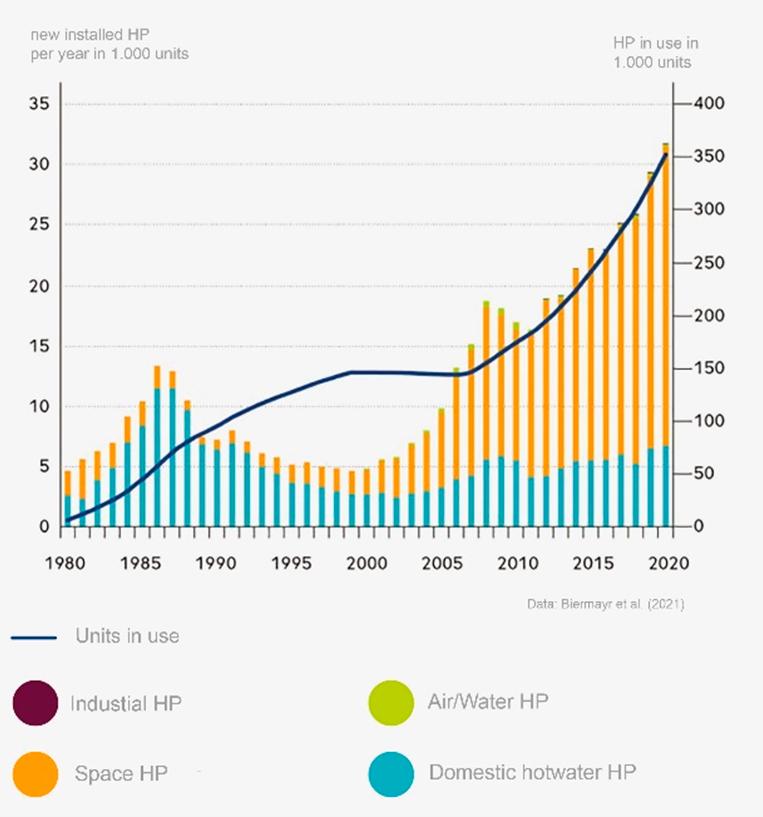
previous year to 57,399 units. This corresponds to a growth of 14.3%. Growth was observed mainly in the domestic market (+21.6%) but also in the export market (+1.9%). Strong growth was particularly noticeable for heat pumps for space heating in the domestic market in all power classes up to 350 kW. Domestic hot water heat pumps showed an increase of 9.3% in the home market and an increase of 23.4% in the export market.
In 2021 the Austrian heat pump sector (production, trade, installation and monetary value of heat) had an amount
Figure 1. All new installed heat pumps per year as well as all heat pumps in use since 1980 in Austria.
Data: Biermayr et al. (2021)
of total sales of 1,015 million Euros and 2,160 full-time jobs. The percentage of the export market was 32.8% in quantity of the total sales in 2021 and, therefore, a little lower than in the previous year. Due to the existing heat pump stock in Austria, about 872,384 tons of CO2equ of net emissions could be avoided in 2021.
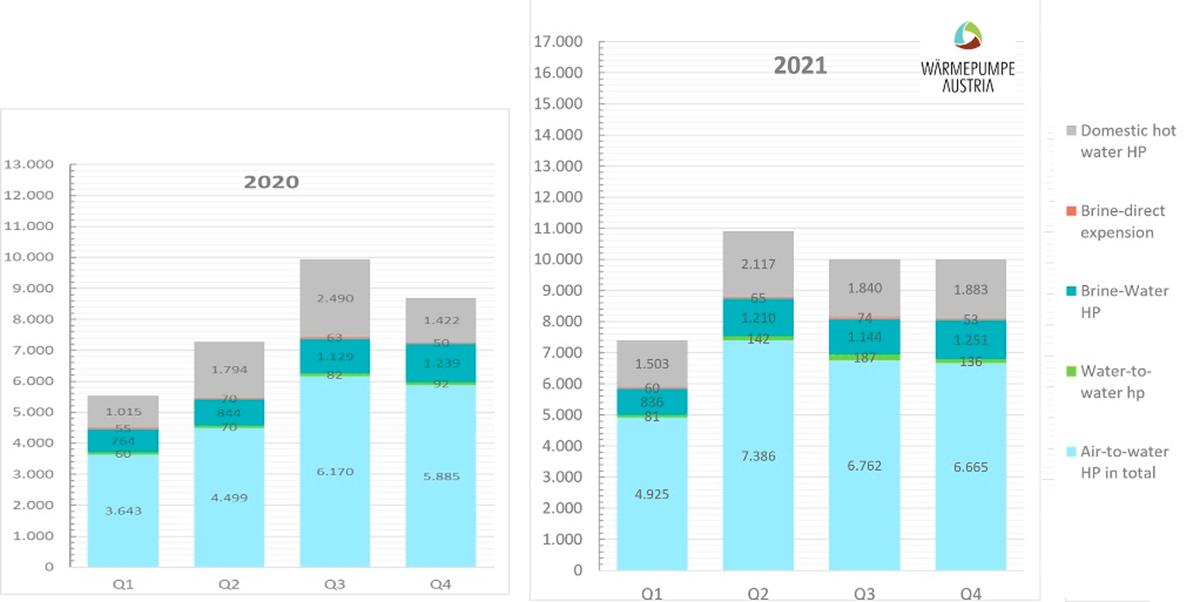
Presently research and development of heat pump systems focus on innovative installations combined with other technologies: e.g. solar thermal systems or photovoltaic systems, new energy services such as air-
conditioning, space cooling, or applications in the context of renovating buildings in regard to humidity problems. The range of innovations is completed with the use of heat pump technology in smart grids.
The market scenarios developed are based on findings from finished research projects, analysis of the historical market development, and results from the series of expert workshops held. They are presented for the different heat pump types and capacities as yearly sales
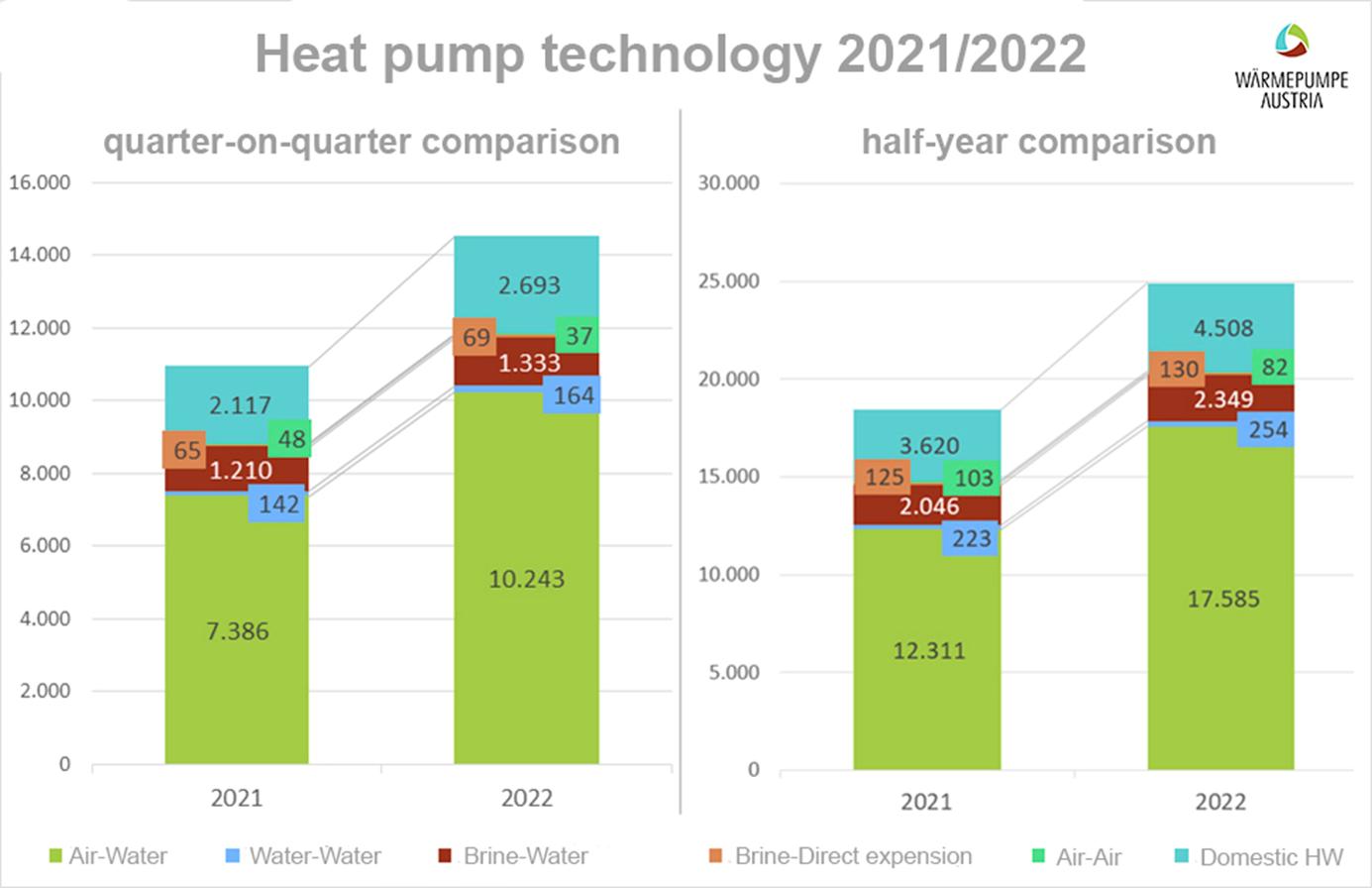
Figure 4. Results of the scenarios up to 2030 for the aggregate of the heat pump for space heating (all power classes). Shown are the annual sales and the number of systems in operations.
numbers and numbers of heat pump systems in opera tion for the period 2015 to 2030 quantitatively and qual itatively. For each heat pump type and capacity range, three scenarios – low, medium, and high – were developed.
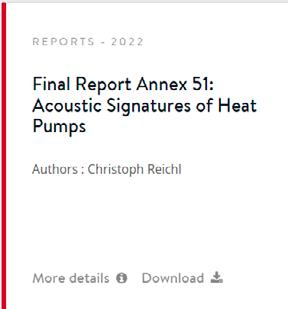

The distribution of heat pumps for space heating (H-HP) onto the two capacity ranges up to 10kW and from 10 to 20kW will depend on the quality of thermal renovation work undertaken till 2030. In case the average quality of the renovation is high, the lower capacity range will dominate. If the quality of the renovation is low, the high er of the two capacity ranges will profit. The future sales figures of heat pumps for space heating will mainly de pend on how heat pumps will be recognized as sustain able heating systems in the refurbishment segment, on
how the challenge of noise emission of air/water systems can be overcome, and how the exogenous factors such as the prices for heating oil or natural gas will develop till 2030. According to industry experts, the influence of na tional market stimulating programs will decrease. In 2015, two of three heat pumps were sold without state subsidies.
SIEGFRIED THURNER Geschäftsführung Verband Wärmepumpe Austria Austria
thurner@waermepumpe-austria.at https://doi.org/10.23697/4w13-ks03
Welcome to the HPT TCP publications database

Here you find the results of international collaboration projects, i.e. Annexes, implemented by the Technology Collaboration Programme on Heat Pumping Technologies, HPT TCP, and Heat Pump Centre, HPC.
https://heatpumpingtechnologies.org/publications
Do you want to read more about the results and outcomes of the HPT TCP Annexes?
2023
4–8 February
ASHRAE's Winter Conference Omni Hotel at CNN Center and Georgia World Congress Center https://www.ashrae.org/conferences/2023-winter-conference-atlanta
6–8 February
AHR Expo
Explore the latest trends and applications in HVACR Technology Georgia World Congress Center Atlanta, Georgia
14–16 March
The 23rd edition of ACREX INDIA 2023 Mumbai, India https://www.acrex.in/
4–6 April
3rd IIR Conference on HFO Refrigerants and Low GWP Blends Shanghai, China
https://iifiir.org/en/events/3rd-iirconference-on-hfo-refrigerantsand-low-gwp-blends-f026669c-85d44f22-900e-6d6e04e5adaa
24–28 April
17th CRYOGENICS 2023 IIR Conference Dresden, Germany https://www.cryogenics-confer ence.eu/cryogenics2023
27–29 April
10th IIR Conference on Ammonia and CO2 Refrigeration Technologies
Ohrid, R. Macedonia https://iifiir.org/en/ events/10th-iir-conference-on-am monia-and-co2-refrigeration-tech nologies
15–18 May
The 14th IEA Heat Pump Conference (HPC2023) Chicago, Illinois, United States https://www.hpc2023.org/
8–9 June 20th European Conference Milan, Italy https://www.centrogalileo.it/
24–28 June
ASHRAE 2023 Annual Conference Tampa, Florida, USA https://www.ashrae.org/conferences/2023-annual-conference-tampa
21–25 August
26th IIR International Congress of Refrigeration Paris, France https://www.icr2023.org/
11–13 September 13th International Conference on Compressors and their Systems London, United Kingdom https://citycompressorsconference. london/
24–25 October
European Heat Pump Summit 2023 Exhibition Center, Nuremberg, Germany https://www.nuernberg messe.de/en/events/europe an-heat-pump-summit-2023
1–30 June, 2024 8th IIR Conference on Sustainability and the Cold Chain Tokyo, Japan
11–14 August, 2024 16th IIR-Gustav Lorentzen Conference on Naturals Refrigerants
University of Maryland, United States
1–30 September, 2024 11th IIR Conference on Compressors and Refrigerants Bratislava, Slovak (Republic)
1–30 September, 2024 10th IIR Conference on Caloric Cooling and Applications of Caloric Materials Baotou, China
8 – 10 October, 2024 Chillventa 2024 - Refrigeration, AC & Ventilation, Heat Pumps Exhibition Nuremberg, Germany
Please check for updates for any conference that you plan to attend. Venues and dates may change, due to the pandemic. IN THE NEXT
AUSTRIA
Dr. Thomas Fleckl
Austrian Institute of Technology Tel: +43 50550-6616 thomas.fleckl@ait.ac.at
BELGIUM
Ms. Ellen Van Mello
ODE – Organization for Sustainable Energy Tel: + 32 476792824 ellen.vanmello@ode.be
CANADA
Dr. Sophie Hosatte Ducassy
CanmetENERGY
Natural Resources Canada
Tel: +1 450 652 5331 sophie.hosatte-ducassy@canada.ca
CHINA
Prof. Xu Wei
China Academy of Building Research
Tel: +86 10 84270105 xuwei19@126.com
Mr. Tomáš Caha
Exergie.CZ
Tel: +420 725 505 055 tc@exergie.cz
DENMARK
Mr. Svend Pedersen
Danish Technological Institute Tel: +45 72 20 12 71 svp@teknologisk.dk
FINLAND
Mr. Jussi Hirvonen
Finnish Heat Pump Association Tel: +35 8 50 500 2751 jussi.hirvonen@sulpu.fi
The International Energy Agency (IEA) was established in 1974 within the frame work of the Organization for Economic Co-operation and Development (OECD) to implement an International Energy Programme. A basic aim of the IEA is to foster co-operation among its participat ing countries, to increase energy security through energy conservation, develop ment of alternative energy sources, new energy technology and research and de velopment.
Technology Collaboration Programme on Heat Pumping Technologies (HPT TCP) International collaboration for energy efficient heating, refrigeration, and air-conditioning.
Mr. Paul Kaaijk
ADEME
Tel: +33 4 93 95 79 14 paul.kaaijk@ademe.fr
Dr. Rainer Jakobs
Informationszentrum Wärmepumpen und Kältetechnik Tel. + 49 6163 57 17 jakobs@izw-online.de
Dr. Maurizio Pieve ENEA, Energy Technologies Dept. Tel. +39 050 621 36 14 maurizio.pieve@enea.it
Mr. Tetsushiro Iwatsubo
New Energy and Industrial Technology Development Organization Tel +81-44-520-5281 iwatsubotts@nedo.go.jp
Mr. Takahiro Asahi
Heat Pump and Thermal Storage Technology Center of Japan (HPTCJ) Tel: +81 3 5643 2404 asahi.takahiro@hptcj.or.jp
Ms. Marion Bakker Netherlands Enterprise Agency (RVO) Tel: +31 88 042 2677 marion.bakker@rvo.nl
Mr. Rolf Iver Mytting Hagemoen NOVAP Tel. +47 971 29 250 river@novap.no
Heat pumping technologies are the cornerstone for a secure, affordable, high-efficiency, clean and net-zero emis sion energy system for heating, cooling and refrigeration. We are the key world wide independent actor to achieve this vision across multiple applications and contexts.
We generate and communicate informa tion, expertise and knowledge related to heat pumping technologies as well as en hance international collaboration.
Mission To accelerate the transformation to an efficient, renewable, clean and secure energy sector in our member countries
SOUTH KOREA
Mr. Hyun-choon Cho KETEP
Tel: +82 2 3469 8301 energykorea@ketep.re.kr
SWEDEN
Ms. Emina Pasic Swedish Energy Agency Tel: +46 16 544 2189 emina.pasic@energimyndigheten.se
SWITZERLAND
Mr. Stephan Renz
Beratung Renz Consulting Tel: +41 61 271 76 36 renz@renzconsulting.ch
Mr. Oliver Sutton
Department for Business, Energy & Industrial Strategy
Tel: +44 300 068 6825 oliver.sutton@beis.gov.uk
UNITED STATES
Dr. Brian Fricke
Building Equipment Research Building Technologies Research & Integration Center Tel: +1 865 576 0822 frickeba@ornl.gov
Ms. Melissa Voss Lapsa – Coordinator
Building Envelope & Urban Systems Research Building Technologies Research & Integration Center Tel: +1 865 576 8620 lapsamv@ornl.gov
and beyond by performing collaborative research, demonstration and data col lection and enabling innovations and de ployment within the area of heat pumping technologies.
A central role within the HPT TCP is played by the Heat Pump Centre (HPC). The HPC contributes to the general aim of the HPT TCP, through information ex change and promotion. In the member countries, activities are coordinated by National Teams. For further information on HPC products and activities, or for general enquiries on heat pumps and the HPT TCP, contact your National Team at www.heatpumpingtechnologies.org/con tact-us/
The Heat Pump Centre is operated by RISE Research Institutes of Sweden.
Heat Pump Centre c/o RISE Research Institutes of Sweden P.O. Box 857 SE-501 15 Borås Sweden
Tel: +46 10 516 53 42 hpc@heatpumpcentre.org www.heatpumpingtechnologies.org
Disclaimer: The HPT TCP is part of a network of autonomous collaborative partnerships focused on a wide range of energy technologies known as Technology Collaboration Programmes or TCPs. The TCPs are organised under the auspices of the International Energy Agency (IEA), but the TCPs are functionally and legally autonomous. Views, findings and publications of the HPT TCP do not necessarily represent the views or policies of the IEA Secretariat or its individual member countries.